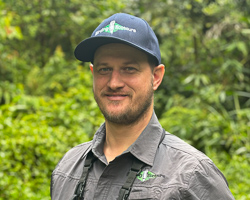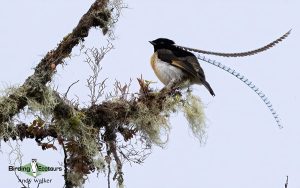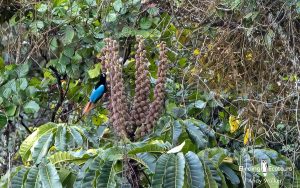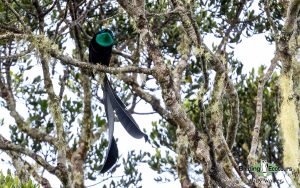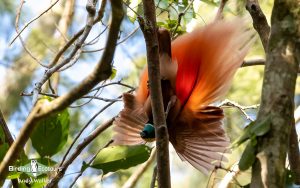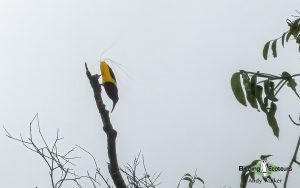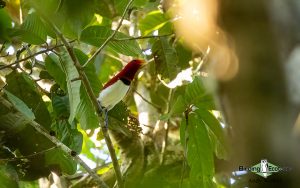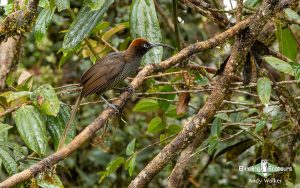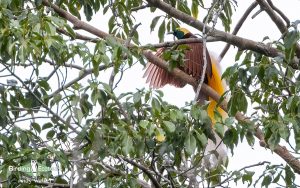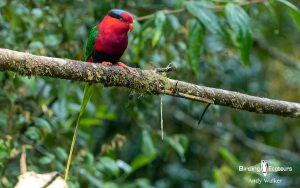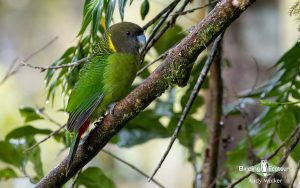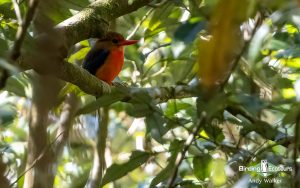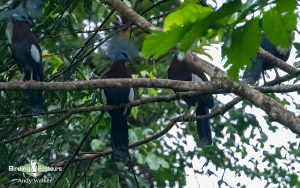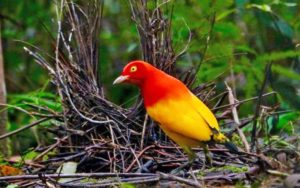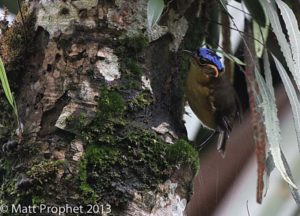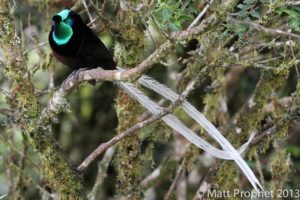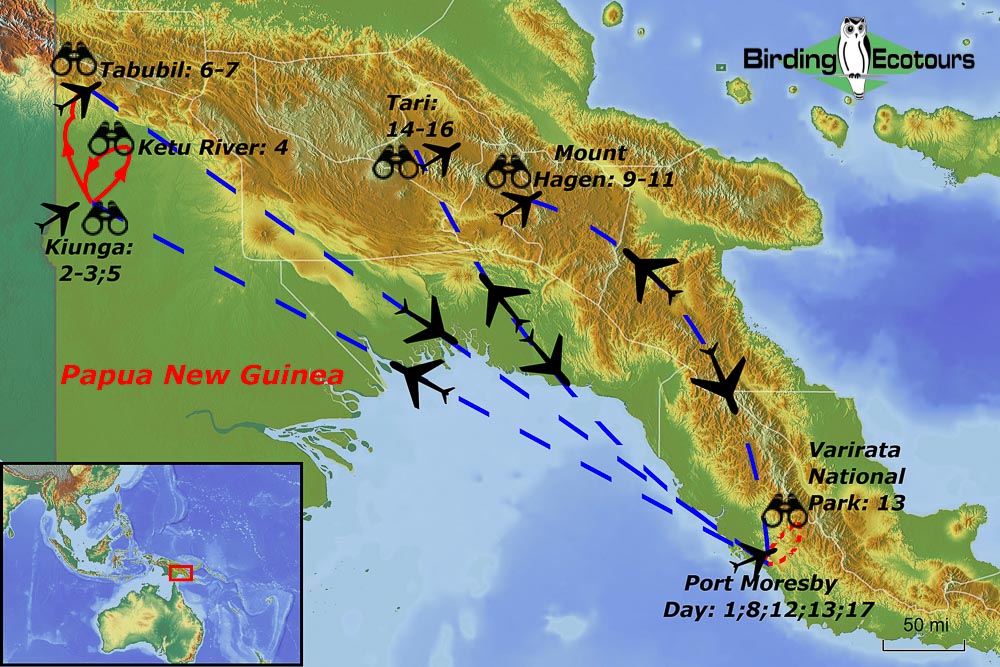Papua New Guinea: Birding Attenborough’s Paradise
Go to: New Guinea Birding Tours | Papua New Guinea Birding Tours | Birding Tours in Asia | All our birding tours
Papua New Guinea: Birding Attenborough’s Paradise
August 2025
Papua New Guinea (PNG) is undoubtedly a birder’s paradise. Thirty-four birds-of-paradise (BoPs) live on the island of New Guinea, of which 31 can be found in PNG, and a large number of these are possible on this tour – get ready for sensory overload! The island is home to approximately 400 endemic bird species. Together with awe-inspiring scenery, endless rainforests, and fascinating highland societies that only made contact with the outside world in the 1930s, this makes PNG a definite must-see destination for any avid birder and nature enthusiast.
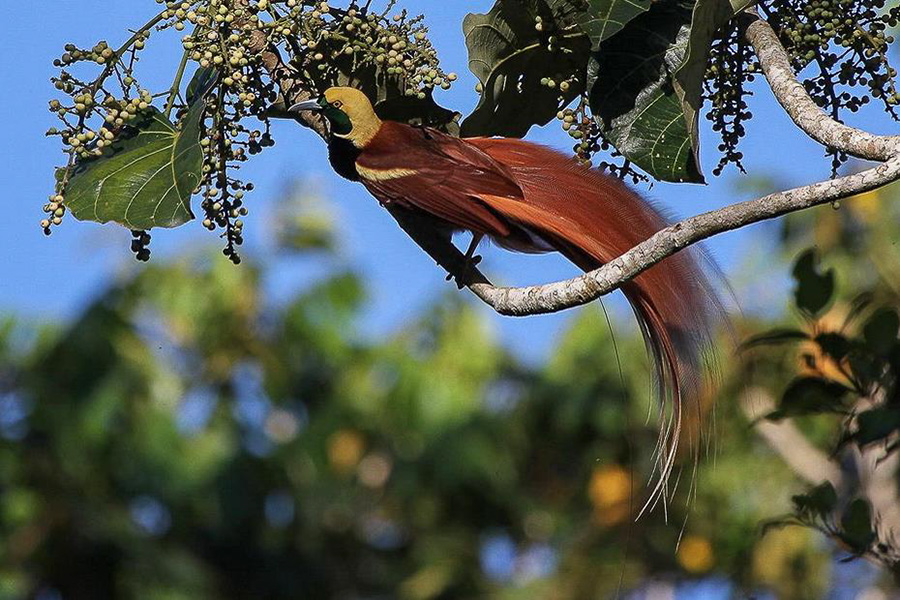
Our first birding will be in the western lowlands around Kiunga, a port town on the Fly River in the Western Province of PNG. In this remote part of the country (including Kwatu Lodge) we will search for a host of breathtaking specials, including the giant Sclater’s (formerly Southern) Crowned Pigeon, the bizarre Twelve-wired Bird-of-paradise, the gorgeous King Bird-of-paradise, and positively glowing Flame Bowerbird!
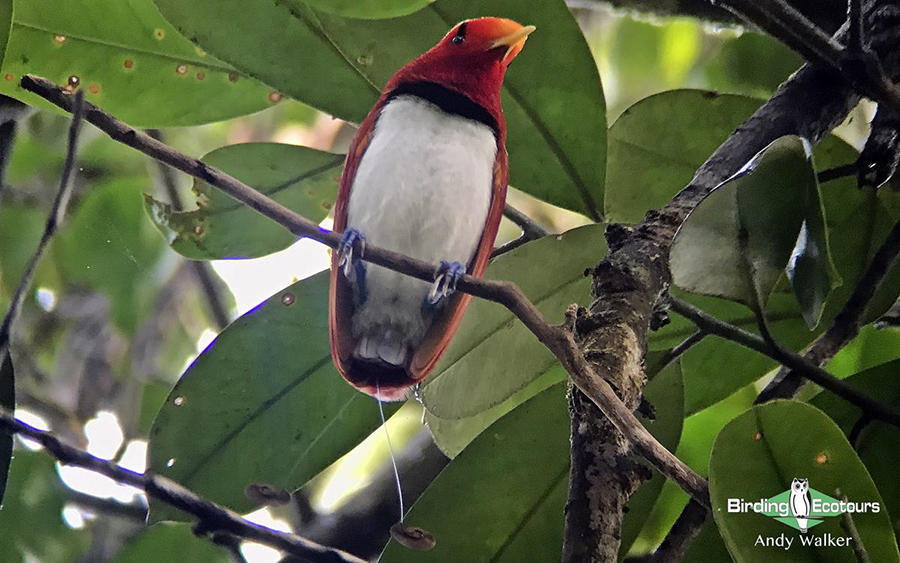
Our next stop is the little-visited Star Mountains, where we search for some hard-to-find and highly sought species, such as Queen Carola’s Parotia, Greater Melampitta, and Shovel-billed Kookaburra.
After the Star Mountains, we will fly to the Mount Hagen Highlands, where we base ourselves at Rondon Ridge Lodge and Kumul Lodge, the holy grails of PNG highland birding sites. We will have our first look for Blue Bird-of-paradise and at Kumul’s legendary feeding table some of PNG’s most spectacular birds await us in the form of Ribbon-tailed Astrapia (surely one of the best-looking of the island’s birds-of-paradise?), Brehm’s Tiger Parrot, Archbold’s Bowerbird, Crested Satinbird, and more. The Mount Hagen area also holds a host of other bird-of-paradise gems such as Brown Sicklebill, Greater Lophorina (formerly part of the Superb Bird-of-paradise complex), King of Saxony Bird-of-paradise, and Lesser Bird-of-paradise.
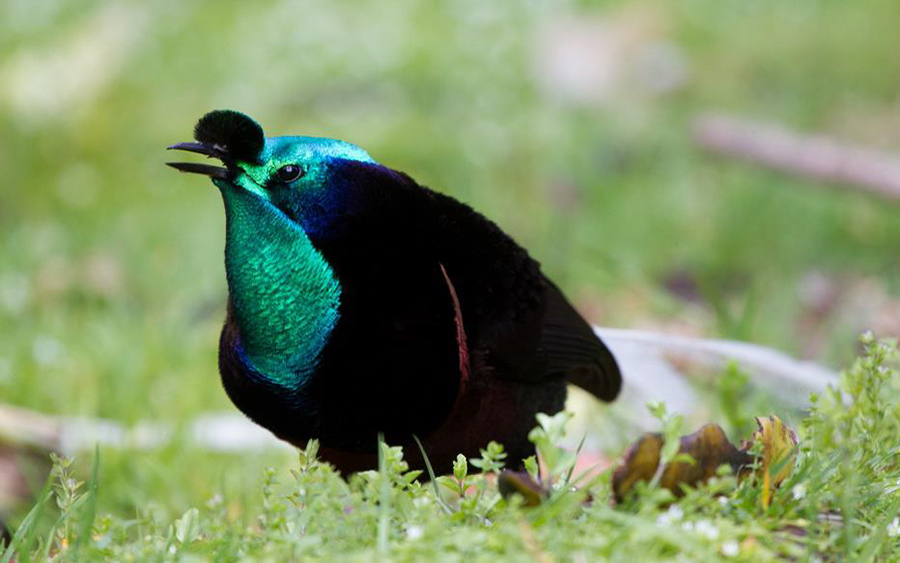
After our birding at Mount Hagan, we will explore some of the areas around Port Moresby, such as Varirata National Park. Varirata is home to the beautiful Raggiana Bird-of-paradise, Hooded Pitohui, an array of spectacular fruit doves, and much more. Other species to be found around the city include the remarkable and huge Papuan Frogmouth, the localized Fawn-breasted Bowerbird, and several gorgeous kingfishers such as Blue-winged Kookaburra, Yellow-billed Kingfisher, and Brown-headed Paradise Kingfisher.
Our final birding of this tour will see us fly to Tari, the capital of the Tari-Pori district. More dazzling birds await us here, like the unique Blue Bird-of-paradise, Lawes’s Parotia, Princess Stephanie’s Astrapia, Papuan Eagle (sometimes referred to as Papuan Harpy Eagle), and many more staggering birds. The Tari region is also home to the legendary Huli Wigmen, and our tour includes the opportunity to experience this unique cultural attraction.
This tour will give you an unforgettable experience of birding in PNG, one of the most amazing destinations in the world, providing you with a lifetime of memories of the simply gorgeous birds-of-paradise, as well as a long list of other impressive, unique and endemic birds.
You may also like to consider our Papua New Guinea: New Britain Premium Extension – Bismarck Archipelago Birding tour. This short tour focuses on New Britain, Bismarck Archipelago, and Solomon Islands endemics, with highlights including Melanesian Megapode, Blue-eyed Cockatoo, Black-capped Paradise Kingfisher, New Britain Dwarf Kingfisher, Bismarck (New Britain) Pitta, and Golden Masked Owl.
Detailed Itinerary (17 days/16 nights)
Day 1. Arrival in Port Moresby
After your morning arrival at Port Moresby’s Jacksons International Airport, we will transfer to the nearby Airways Hotel. After check-in we proceed to an afternoon of introductory Papuan birding at the grounds of Pacific Adventist University. This part of New Guinea has a feel of being in northeast Australia and we might find a wide-range of species here such as Comb-crested Jacana, Radjah Shelduck, Torresian Imperial Pigeon, Pied Heron, Nankeen Night Heron, Papuan Eclectus, Blue-winged Kookaburra, Fawn-breasted Bowerbird, Yellow-faced Myna, and if we are lucky, Glossy-mantled Manucode – potentially our first bird-of-paradise, of many, on this exciting tour.
Overnight: Airways Hotel, Port Moresby
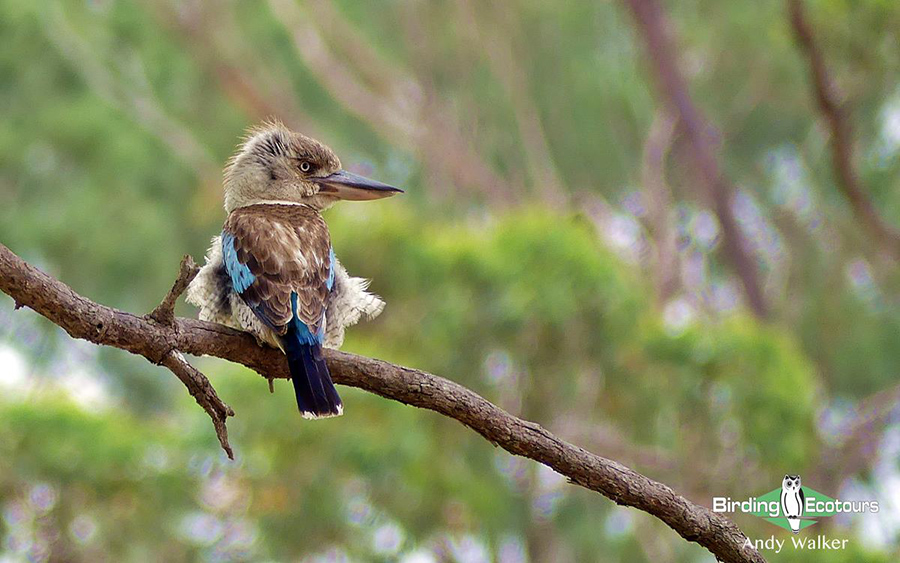
Day 2. Flight to Kiunga
This morning we will transfer back to the airport for a flight from Port Moresby to Kiunga. We will be met and transferred to Kiunga Guesthouse along the remote Fly River. In the afternoon we will enjoy some birding, if time permits, making a start on the birds listed for Day 3.
Overnight: Kiunga Guesthouse, Kiunga
Day 3. Birding the Kiunga area
Kiunga is surrounded by vast tracts of swamp forest and spectacular lowland rainforest. Several birds-of-paradise can be found here, including Greater Bird-of-paradise, Twelve-wired Bird-of-paradise, Trumpet Manucode, and Glossy-mantled Manucode.
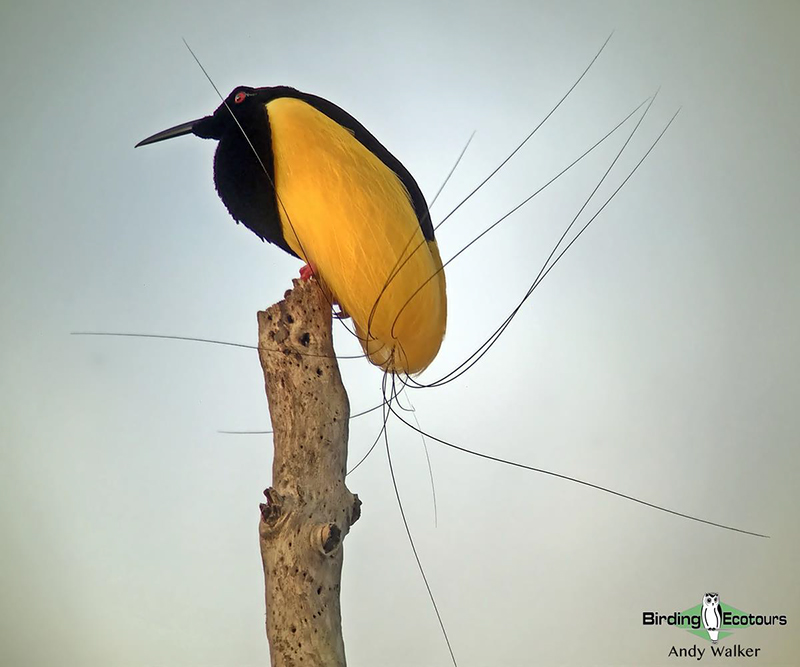
Some other pretty impressive birds also occur here too and will form the focus of our attention, namely Sclater’s Crowned Pigeon, Flame Bowerbird, New Guinea Flightless Rail, Large Fig Parrot, Little Paradise Kingfisher, White-bellied Pitohui, and Yellow-eyed Starling.
Yet more highlights from this area could include Forest Bittern, Long-tailed Honey Buzzard, Collared Imperial Pigeon, Palm Cockatoo, Pesquet’s (New Guinea Vulturine) Parrot, Red-cheeked Parrot, Dusky-cheeked (Orange-breasted) Fig Parrot, Yellow-capped Pygmy Parrot, Long-billed Cuckoo, Hooded Pitta, Papuan Pitta, Blue Jewel-babbler, Emperor Fairywren, Common Paradise Kingfisher, Hook-billed Kingfisher, and White-spotted Mannikin.
Overnight: Kiunga Guesthouse, Kiunga
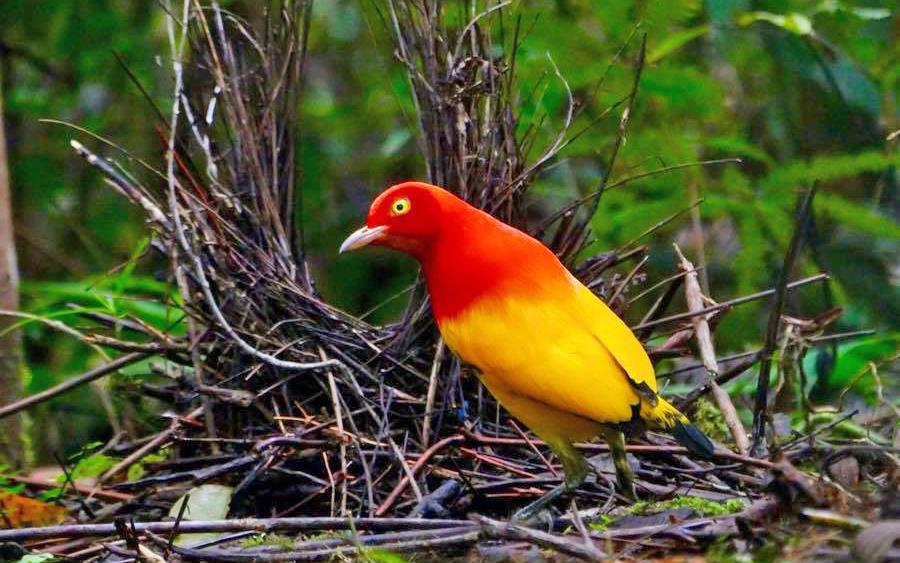
Day 4. Transfer by boat to Kwatu Lodge, birding en route and at Kwatu Lodge
In the early morning we will travel by boat up the Elavala River and its tributary, the Ketu River, until we arrive at the locally owned Kwatu Lodge. We will be birding en route, and we might find Black-billed Brushturkey, Great-billed Heron, Great Cuckoo-Dove, Sclater’s Crowned Pigeon, Beautiful Fruit Dove, Papuan Spine-tailed Swift, Blyth’s Hornbill, Azure Kingfisher, Papuan Dwarf Kingfisher, Common Paradise Kingfisher, Palm Cockatoo, Golden Monarch, Golden Myna, and Grey Crow.
In the afternoon, and the following morning, we will be birding around the lodge and the wider area where we might encounter some really exciting species such as Dwarf Cassowary, New Guinea Flightless Rail, Pygmy Eagle, Wallace’s Owlet-nightjar, Starry Owlet-nightjar, Marbled Frogmouth, Papuan Hawk-Owl, Common Paradise Kingfisher, Hook-billed Kingfisher, Blue Jewel-babbler, Painted Quail-thrush, Papuan Babbler, Glossy-mantled Manucode, Twelve-wired Bird-of-paradise, and King Bird-of-paradise.
There are plenty of other great birds here too, and we will be keeping our eyes peeled for the likes of Doria’s Goshawk, Grey-headed Goshawk, Variable Goshawk, Orange-bellied Fruit Dove, Pink-spotted Fruit Dove, Palm Cockatoo, Red-cheeked Parrot, Papuan Eclectus, Ivory-billed Coucal, Blyth’s Hornbill, Hooded Pitta, Moustached Treeswift, Southern Variable Pitohui, Shining Flycatcher, Black-sided Robin, Frilled Monarch, Hooded Butcherbird, Boyer’s Cuckooshrike, Golden Cuckooshrike, White-bellied Thicket Fantail, Lowland Peltops, and Black Sunbird.
Overnight: Kwatu Lodge, Ketu River
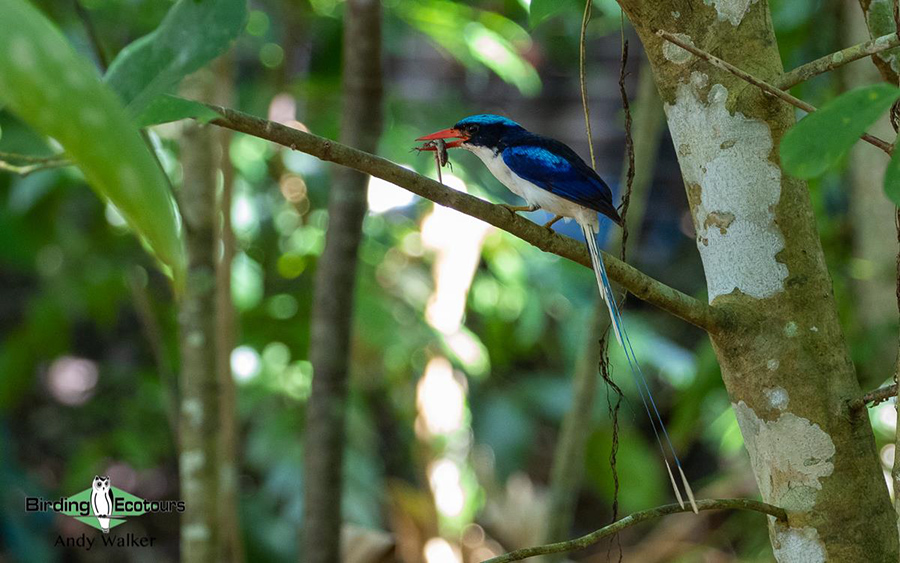
There are so many other amazing birds around the Mount Hagen environs and some of the other birds that we hope to see here over the course of our visit include Papuan Harrier, New Guinea Woodcock, Chestnut Forest Rail, Goldie’s Lorikeet, Papuan Lorikeet, Yellow-billed Lorikeet, Orange-billed Lorikeet, Mountain Owlet-nightjar, Lesser Melampitta, Loria’s Satinbird, Crested Satinbird, Black-breasted Boatbill, White-winged Robin, Garnet Robin, Black-headed Whistler, Regent Whistler, Rufous-naped Bellbird (formerly called Rufous-naped Whistler but moved from that family to a new family called Australo-Papuan bellbirds), Black Sittella, Ornate Melidectes, Grey-streaked Honeyeater, Fan-tailed Berrypecker, Crested Berrypecker, Tit Berrypecker, Mountain Firetail, Yellow-breasted Bowerbird, Torrent Flyrobin, and Torrent-lark. To complement the above there are also three additional species in the area that are all monotypic families, so of interest to any family listers. These three are Mottled Berryhunter, Blue-capped Ifrit, and Wattled Ploughbill, we could see all three here.
Overnight: Kumul Lodge, Mount Hagen
Day 5. Birding around Kwatu Lodge, transfer by boat back to Kiunga
In the morning we will be birding the area around the Ekame and Kwatu lodges looking for some of the birds mentioned above. In the afternoon we will travel downriver by boat back to Kiunga. On arrival in Kiunga we will transfer to the Kiunga Guesthouse.
Overnight Kiunga Guesthouse, Kiunga
Day 6. Transfer to the Star Mountains
Today we will have a full-day road tour from Kiunga to Tabubil in the Star Mountains, birding en route, during which time we might see Long-tailed Honey Buzzard, Grey Crow, Papuan Mountain Pigeon, Amboyna Cuckoo-Dove, White-crowned Cuckoo, New Guinea Friarbird, Glossy Swiftlet, and Moustached Swiftlet.
Overnight: Hotel Cloudlands, Tabubil
Day 7. Birding the Star Mountains
For a full day we will explore the wonderful Star Mountains (Tabubil area). During this time, we might encounter a couple of new birds-of-paradise such as the ballet-dancing Queen Carola’s Parotia the giant Black Sicklebill, and the unusual Short-tailed Paradigalla to go with further opportunities for Greater Lophorina, Magnificent Riflebird, Greater Bird-of-paradise, and Magnificent Bird-of-paradise.
There are lots of other targets for us here with some of the more interesting birds likely to include Salvadori’s Teal, New Guinea Bronzewing, Pesquet’s (New Guinea Vulturine) Parrot, Dusky Lory, Striated Lorikeet, Red-breasted Pygmy Parrot, Blue-collared Parrot, Shovel-billed Kookaburra, Hook-billed Kingfisher, Mountain Kingfisher, Papuan Boobook, Golden Cuckooshrike, Chestnut-backed Jewel-babbler, Wallace’s Fairywren, White-rumped Robin, Obscure Berrypecker, Piping Bellbird (formerly called Crested Pitohui and part of the whistler family, but recently moved to a new family called Australo-Papuan bellbirds), Hooded Pitohui, Capped White-eye, Mountain Peltops, Mountain Honeyeater, Ornate Melidectes, Yellow-browed Melidectes, Loria’s Satinbird, and Greater Melampitta.
Overnight: Hotel Cloudlands, Tabubil
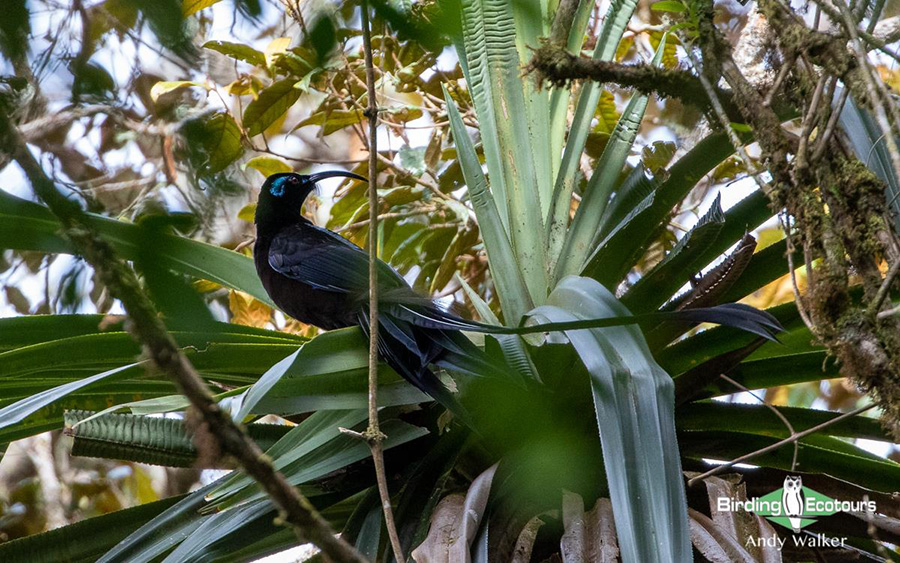
Yet more highlights from this area could include Forest Bittern, Long-tailed Honey Buzzard, Collared Imperial Pigeon, Palm Cockatoo, Pesquet’s (New Guinea Vulturine) Parrot, Red-cheeked Parrot, Orange-breasted Fig Parrot, Yellow-capped Pygmy Parrot, Long-billed Cuckoo, Hooded Pitta, Papuan Pitta, Blue Jewel-babbler, Emperor Fairywren, Common Paradise Kingfisher, Hook-billed Kingfisher, and White-spotted Mannikin.
Overnight: Kiunga Guesthouse, Kiunga
Day 8. Flight to Port Moresby
We will take an early morning trip to check out sites for both Greater Bird-of-paradise and King Bird-of-paradise. We will then transfer to a flight from Tabubil to Port Moresby. On arrival we will be met and transferred to our hotel in the city.
Overnight: Airways Hotel, Port Moresby
Day 9. Flight to Mount Hagen and birding around Rondon Ridge Lodge
We transfer to the airport for a flight to Mount Hagen. On arrival we will be met and transferred along the scenic mountain road to Rondon Ridge Lodge. The lodge is nestled on the edge of the Waghi Valley above the city of Mount Hagen at around 7,100 feet (2,150 meters), offering a stunning vista of the surrounding highland-style houses and gardens, set amongst the green rolling hills and forest. We should have a good proportion of the day birding in the area around the lodge which has a trail network on its doorstep and great birds in the garden. We will start our pursuit of the stunning Blue Bird-of-paradise while we are in this area, along with Greater Lophorina and many other key target birds.
Overnight: Rondon Ridge Lodge, Mount Hagen
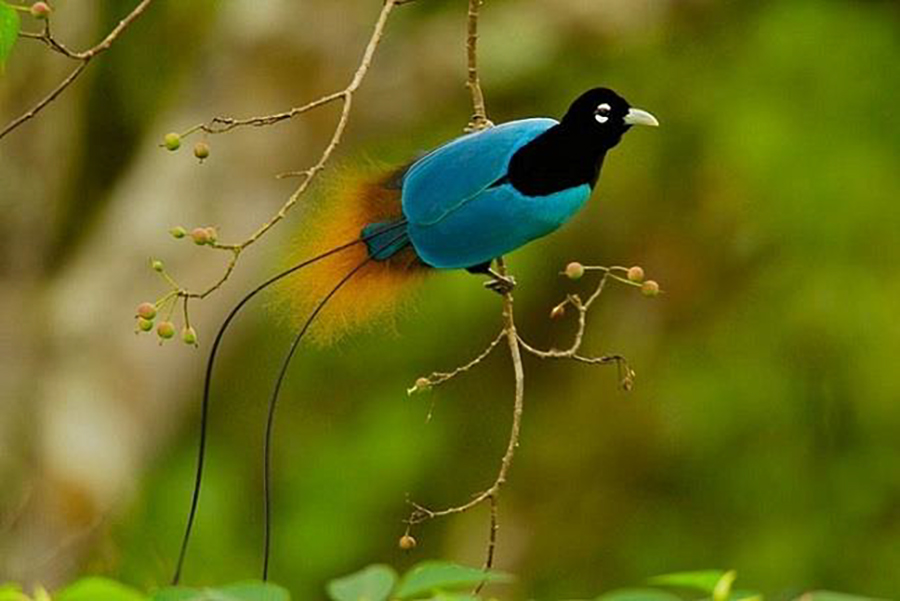
Day 10. Rondon Ridge Lodge to Kumul Lodge
We will transfer between Rondon Ridge Lodge and Kumul Lodge today. Situated at 8,585 feet (2, 861 meters), Kumul Lodge is one of the best-known landowner eco-tourism lodges in all of PNG and provides important income for many local people. The lodge also strives to protect the surrounding forested areas and our time here is sure to be a highlight of the whole tour.
At the lodge bird feeding table we can hope for some spectacular birds, such as Ribbon-tailed Astrapia, Brown Sicklebill, Brehm’s Tiger Parrot, Archbold’s Bowerbird, Crested Satinbird, Island Thrush, Crested Berrypecker, Common Smoky Honeyeater, Belford’s Melidectes, White-winged Robin, Chestnut Forest Rail, and more. It will be hard to pull ourselves away from the feeders but there are so many high quality and localized species to look for in the wider area.
Overnight: Kumul Lodge, Mount Hagen
Day 11. Birding Mount Hagen
We will have a full day (as well as time the previous day after our arrival, and the following day ahead of our departure) birding this avian wonderland, including looking for the rare and range-restricted Blue Bird-of-paradise and many other breathtakingly beautiful members of the bird-of-paradise family, such as Ribbon-tailed Astrapia, Princess Stephanie’s Astrapia, King of Saxony Bird-of-paradise, Magnificent Bird-of-paradise, Brown Sicklebill, Greater Lophorina, Crinkle-collared Manucode, Magnificent Riflebird, and Lesser Bird-of-paradise.
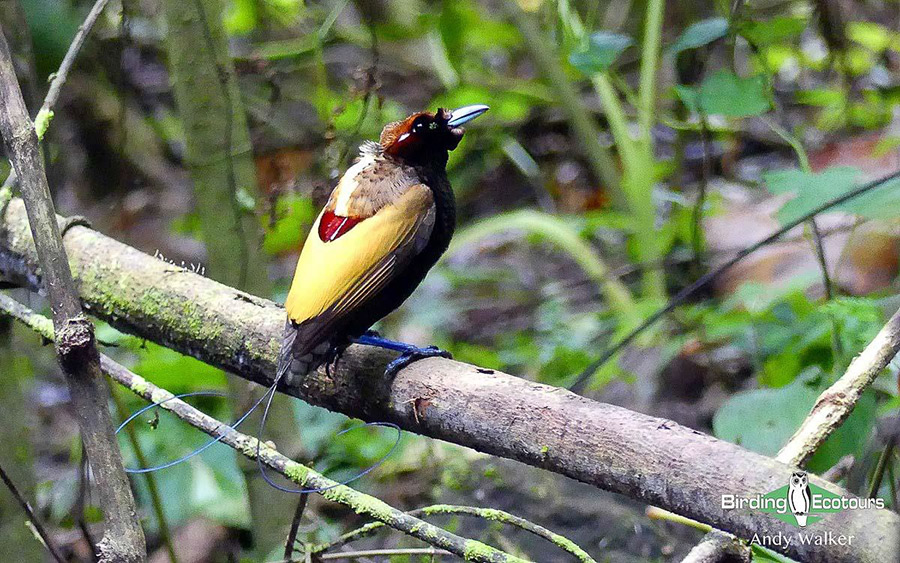
There are so many other amazing birds around the Mount Hagen environs and some of the other birds that we hope to see here over the course of our visit include Papuan Harrier, New Guinea Woodcock, Chestnut Forest Rail, Goldie’s Lorikeet, Papuan Lorikeet, Yellow-billed Lorikeet, Orange-billed Lorikeet, Mountain Owlet-nightjar, Lesser Melampitta, Loria’s Satinbird, Crested Satinbird, Black-breasted Boatbill, White-winged Robin, Garnet Robin, Black-headed Whistler, Regent Whistler, Rufous-naped Bellbird, Black Sittella, Ornate Melidectes, Grey-streaked Honeyeater, Fan-tailed Berrypecker, Crested Berrypecker, Tit Berrypecker, Mountain Firetail, Yellow-breasted Bowerbird, Torrent Flyrobin, and Torrent-lark. To complement the above, there are also three additional species in the area that are all monotypic families, so of interest to any family listers. These three are Mottled Berryhunter, Blue-capped Ifrit, and Wattled Ploughbill, we could see all three here.
Overnight: Kumul Lodge, Mount Hagen
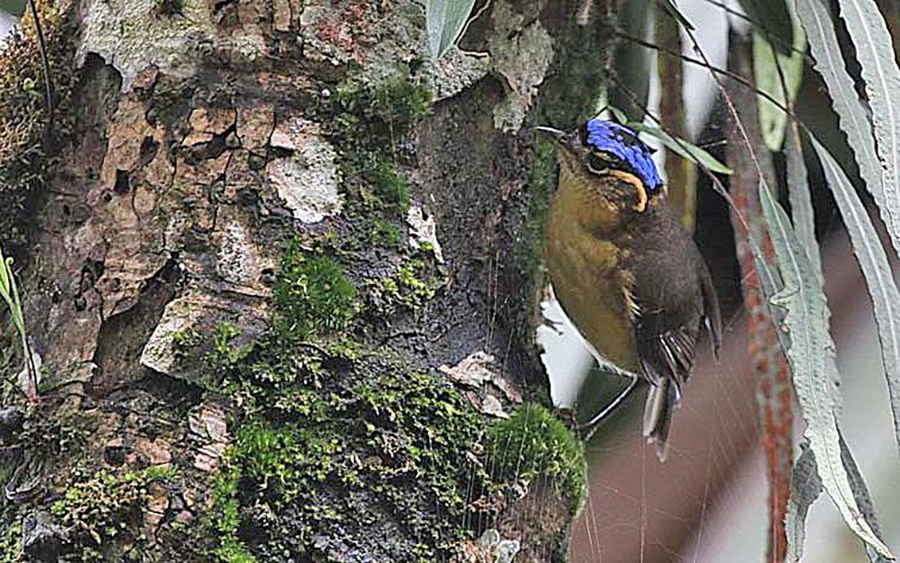
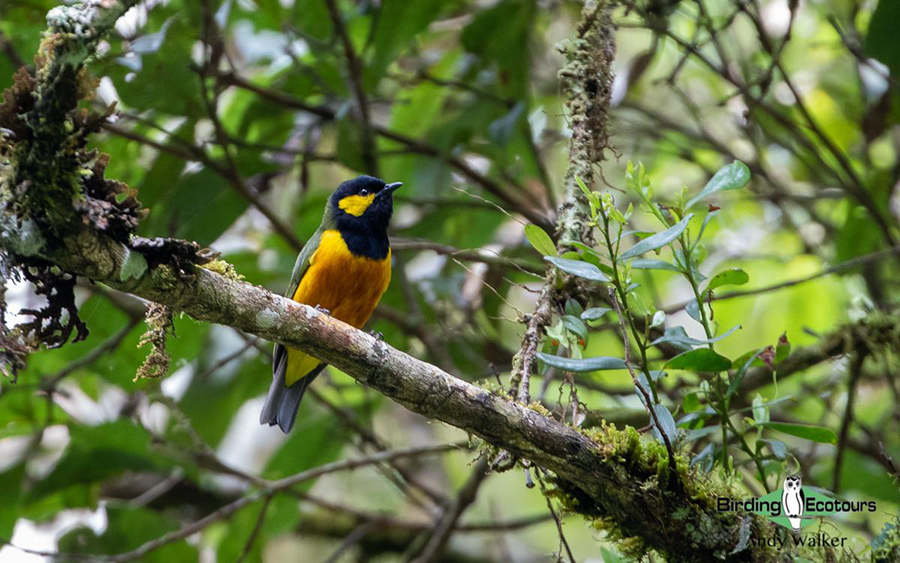
Day 12. Birding Mount Hagen then travel back to Port Moresby
After our final birding session around Kumul Lodge, looking for any of the birds listed above, we will make the journey back down to Mount Hagen before getting our flight back to Port Moresby.
Overnight: Airways Hotel, Port Moresby
Day 13. Varirata National Park
Today we will have a short drive to Varirata National Park, which provides splendid low- and mid-elevation birding. We will spend the day here and might be able to find, among many others, such exciting birds as Barred Owlet-nightjar, Pheasant Coucal, Chestnut-breasted Cuckoo, Brown-headed Paradise Kingfisher, Rufous-bellied Kookaburra, Black Berrypecker, and hopefully PNG’s national bird, Raggiana Bird-of-paradise along with another bird-of-paradise, Growling Riflebird.
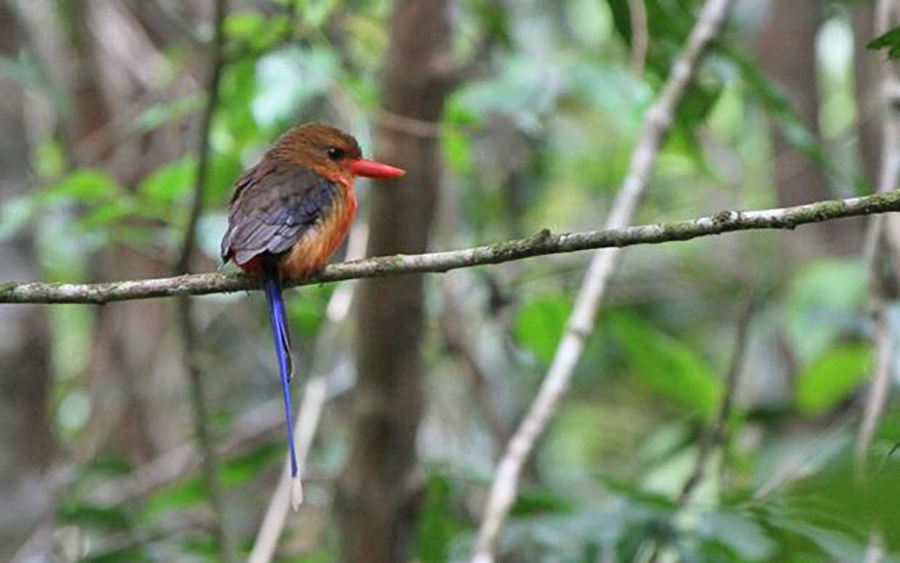
There are so many great birds in Varirata National Park and some of the other highlights here could include Blyth’s Hornbill, Beautiful Fruit Dove, Pink-spotted Fruit Dove, Orange-bellied Fruit Dove, Papuan King Parrot, Yellowish-streaked Lory, Hooded Pitta, Painted Quail-thrush, Chestnut-backed Jewel-babbler, Goldenface, Rusty Pitohui, Yellow-breasted Boatbill, Frilled Monarch, Pygmy Longbill, and Papuan Scrub Robin.
Overnight: Airways Hotel, Port Moresby
Day 14. Flight to Tari, birding the Ambua Gap
This morning after breakfast we will be met and transferred to the airport for a flight from Port Moresby to Tari in Hela Province. On arrival we will be transferred to Ambua Lodge. After check-in we will spend the afternoon birding around the bird-rich Ambua Gap, another of PNG’s famous birding spots (if not, historically, the most famous) and featured in many a wildlife documentary.
Overnight: Ambua Lodge, Tari
Days 15 – 16. Birding the Ambua Gap and the forests and farmland around Ambua
We will have two full days birding in the Ambua area (such as at Tari Gap, Tari Valley, and the delightfully “birdy” farmlands of Wata and Tibiki) looking for new species and trying to improve our views of others from the first two weeks of this exciting and bird-filled tour. Over 220 bird species have been recorded from this area, including 13 species of birds-of-paradise, and in this regard, we will be on the lookout for Lawes’s Parotia, Short-tailed Paradigalla, Princess Stephanie’s Astrapia, Ribbon-tailed Astrapia, King of Saxony Bird-of-paradise, Greater Lophorina, Black Sicklebill, Brown Sicklebill, and Blue Bird-of-paradise.
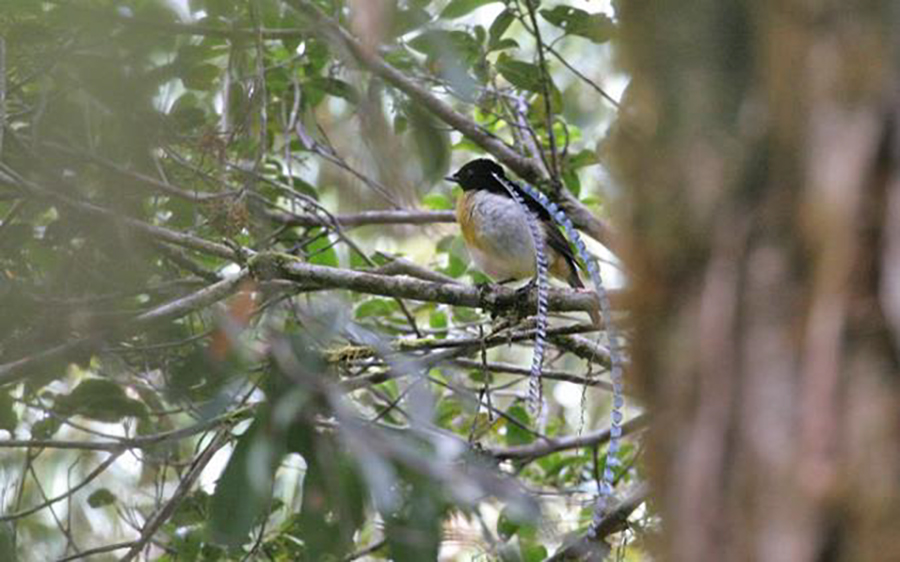
Further potential highlight birds here could include Forbes’s Forest Rail, Papuan Lorikeet, Yellow-billed Lorikeet, Orange-billed Lorikeet, Red-breasted Pygmy Parrot, Brehm’s Tiger Parrot, Painted Tiger Parrot, Modest Tiger Parrot, Madarasz’s Tiger Parrot, Papuan King Parrot, Greater Sooty Owl, Papuan Boobook, Archbold’s Nightjar, Mountain Kingfisher, Spotted Jewel-babbler, Blue-capped Ifrit, Garnet Robin, Black-throated Robin, Lesser Ground Robin, Wattled Ploughbill, Belford’s Melidectes, Yellow-browed Melidectes, Tit Berrypecker, Crested Berrypecker, Great Woodswallow, Archbold’s Bowerbird, MacGregor’s Bowerbird, Lesser Melampitta, Loria’s Satinbird, Long-tailed Shrike, Black Sittella, Papuan Treecreeper, Papuan Grassbird, Canary Flyrobin (Papuan Flycatcher), and Papuan Logrunner.
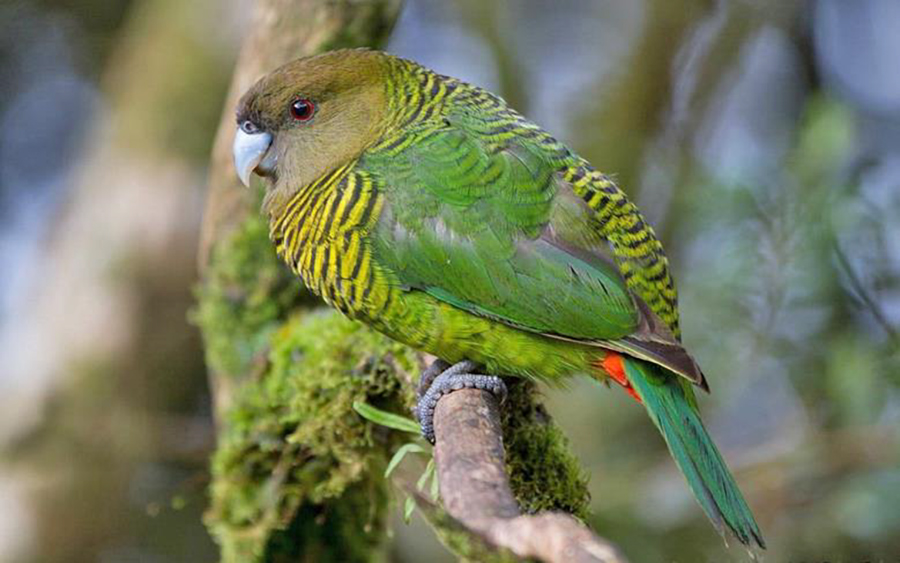
The Tari region is also home to the legendary Huli Wigmen, and our tour includes the opportunity to experience this unique cultural attraction and is something not to be missed and will definitely not be forgotten!
Overnight: Ambua Lodge, Tari
Day 17. Flight to Port Moresby and tour concludes
We will transfer to Tari airport for our morning flight back to Port Moresby. Our tour will conclude on arrival in Port Moresby and you will be able to get your international flight home in the late afternoon or early evening.
Overnight: Not included
Please note that the itinerary cannot be guaranteed as it is only a rough guide and can be changed (usually slightly) due to factors such as availability of accommodation, updated information on the state of accommodation, roads, or birding sites, the discretion of the guides and other factors. In addition, we sometimes have to use a different international guide from the one advertised due to tour scheduling.
Download Itinerary
Papua New Guinea: Birding Attenborough’s Paradise Trip Report, August 2023
19 AUGUST – 04 SEPTEMBER 2023
By Andrew Walker
DOWNLOAD TRIP REPORT
Overview
This Papua New Guinea birding tour started and ended in Port Moresby and ran from the 19th of August 2023 to the 4th of September 2023. During our Papua New Guinea birding tour, we birded and stayed at some of the best birding sites in Papua New Guinea. Birding sites visited during this Papua New Guinea bird tour included Varirata National Park and the Pacific Adventist University campus near Port Moresby, Kiunga on the Fly River, Star Mountains, Kwatu Lodge, Mount Hagen (including Rondon Ridge Lodge and Kumul Lodge), Tari Gap, and Ambua Lodge. Each of the above destinations offered something different in terms of the habitats to explore and the birds present.

The exquisite King of Saxony Bird-of-paradise gave excellent views and was an extremely popular species during our Papua New Guinea birding tour.
We recorded 300 species on the tour (14 of these heard only) which followed on from our short New Britain birding tour. Usually, our New Britain birdwatching tour follows the Papua New Guinea bird tour, but this year it ran ahead of it, due to logistical reasons (see the New Britain trip report here). Trip lists for this Papua New Guinea tour follow the report. Birds-of-paradise were a big focus on the tour given they are some of the most incredible birds on the planet. We recorded 21 species of astonishing birds-of-paradise: Splendid Astrapia, Princess Stephanie’s Astrapia, Ribbon-tailed Astrapia, King of Saxony Bird-of-paradise, Queen Carola’s Parotia, Short-tailed Paradigalla, Black Sicklebill, Brown Sicklebill, Black-billed Sicklebill, Glossy-mantled Manucode, Trumpet Manucode, Crinkle-collared Manucode, Magnificent Riflebird, Growling Riflebird, Greater Lophorina, King Bird-of-paradise, Magnificent Bird-of-paradise, Twelve-wired Bird-of-paradise, Greater Bird-of-paradise, Raggiana Bird-of-paradise, and Blue Bird-of-paradise. All of the above birds-of-paradise were seen, some foraging, and others displaying (including making some incredible sounds). Many species were photographed, and these photos appear throughout the report.
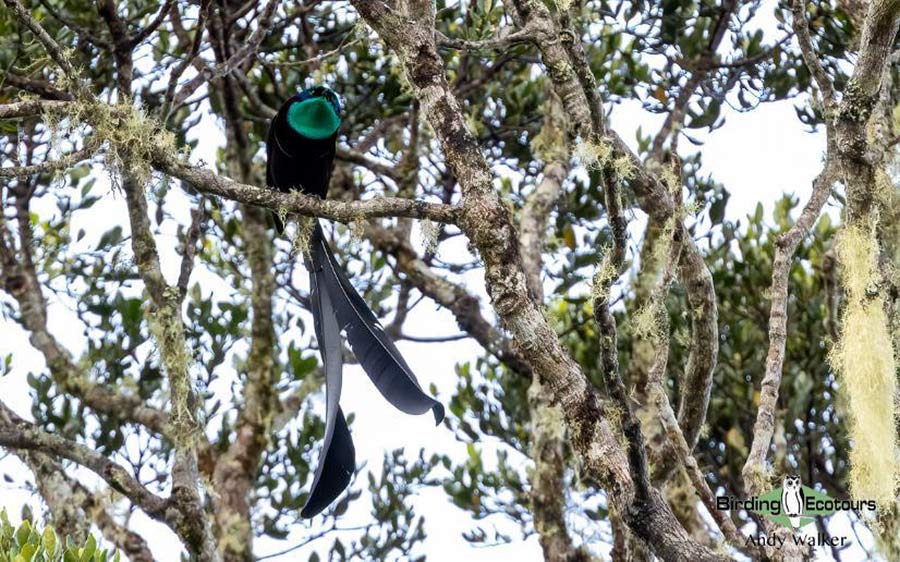
The striking Princess Stephanie’s Astrapia gave some great views during our PNG bird tour.
However, this Papua New Guinea bird tour wasn’t only about the spectacular birds-of-paradise, as the country hosts so many other exceptional birds and endemic bird families that we wanted to also look for. During this Papua New Guinea birding tour we enjoyed sightings of Salvadori’s Teal, Barred Owlet-nightjar, Sclater’s Crowned Pigeon, nine species of gorgeous fruit doves, including Beautiful Fruit Dove, Dwarf Fruit Dove, and Pink-spotted Fruit Dove, Gurney’s Eagle, Papuan Harrier, Papuan Boobook, Blyth’s Hornbill, a dozen species of kingfishers, including Hook-billed Kingfisher, Common Paradise Kingfisher, Little Paradise Kingfisher, Brown-headed Paradise Kingfisher, and Papuan Dwarf Kingfisher, along with Rufous-bellied Kookaburra. Cockatoos and parrots featured heavily with almost 30 species logged, from the giant Palm Cockatoo to the miniscule, Red-breasted Pygmy Parrot, with numerous stunning and colorful birds in between, such as Papuan Eclectus, Stella’s Lorikeet, and Brehm’s Tiger Parrot.

A displaying male Raggiana Bird-of-paradise (the national bird of Papua New Guinea) put on a spectacular show for us, what a sight!
Further highlights included Flame Bowerbird, Emperor Fairywren, 25 species of honeyeaters including the boisterous duo of Belford’s Melidectes and Yellow-browed Melidectes, as well as Papuan Babbler, Loria’s Satinbird, Obscure Berrypecker, Tit Berrypecker, Eastern Crested Berrypecker, Mottled Berryhunter, Papuan Sittella, Regent Whistler, White-bellied Pitohui, Southern Variable Pitohui, Hooded Pitohui, Golden Monarch, Torrent-lark, Grey Crow, Lesser Melampitta, and Blue-capped Ifrit. However, the highlights didn’t stop there, with further special birds including numerous Australian robins, such as White-winged Robin, White-rumped Robin, and Black-sided Robin, along with Papuan Grassbird, Yellow-faced Myna, Golden Myna, Island (Papuan) Thrush, Red-capped Flowerpecker, and Alpine Pipit.
Detailed Report
Day 1, 19th August 2023. Arrival in Port Moresby
Today was an arrival day in Port Moresby. We enjoyed our welcome dinner together and discussed what we were hoping to see on this Papua New Guinea bird tour.
Day 2, 20th August 2023. Flight between Port Moresby and Kiunga, travel to Tabubil
We took a morning flight out of Port Moresby to Kiunga. The flight made a brief touchdown on the island of Daru, where we noted several Australian Pratincoles. We then spent most of the afternoon driving north to the town of Tabubil, passing through some beautiful scenery. A couple of stops near our destination gave us sightings of Grey Crow, Long-tailed Honey Buzzard, Variable Goshawk, Dusky Lory, White-shouldered Fairywren, Black Butcherbird, Hooded Butcherbird, New Guinea Friarbird, Yellow-faced Myna, and Torrent Flyrobin.
Day 3, 21st August 2023. Birding the Star Mountains near Tabubil
We awoke for an early breakfast with a Papuan Boobook showing in the garden. We then spent the day exploring the Star Mountains and had an awesome day of mid- and high-elevation birding, recording eight species of birds-of-paradise including: Splendid Astrapia (our main target), King of Saxony Bird-of-paradise, Queen Carola’s Parotia, Short-tailed Paradigalla, Black Sicklebill, Brown Sicklebill, and Greater Bird-of-paradise which were all seen, with Greater Lophorina heard only. A mega collection of birds and several certain tour highlights seen.
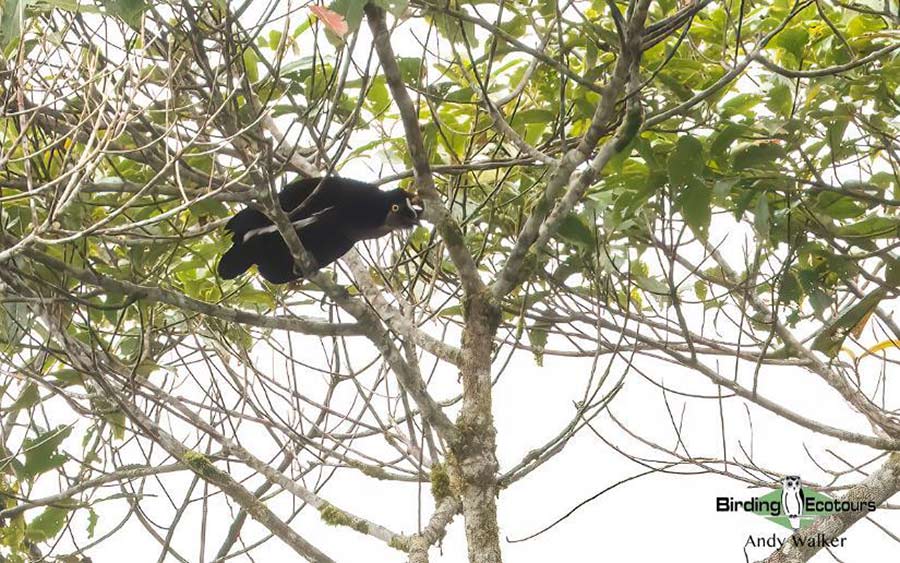
The gorgeous Queen Carola’s Parotia was one of the highlight birds-of-paradise of the tour.
Loads of other birds were seen across the day as we birded at a range of elevations. Some of the highlights included Red-breasted Pygmy Parrot, Fairy Lorikeet, Orange-billed Lorikeet, Dusky Lory, Grey-streaked Honeyeater, Common Smoky Honeyeater, Mountain Myzomela, Red-collared Myzomela, Mountain Honeyeater, Black-throated Honeyeater, Belford’s Melidectes, Black-breasted Boatbill, Mountain Peltops, Hooded Cuckooshrike, Grey-headed Cuckooshrike, Regent Whistler, Black Fantail, Friendly Fantail, Torrent-lark, Slaty Robin, Torrent Flyrobin, Island Leaf Warbler, and Island (Papuan) Thrush.
Day 4, 22nd August 2023. Birding near Tabubil and travel to Kiunga
We spent the morning birding near Tabubil and found some great birds. First up was a small group of roosting Great Woodswallows, quickly followed up with a pair of Salvadori’s Teals on a river, along with Torrent Flyrobins too. Nearby we found Tawny-breasted Honeyeater and over the course of the morning also found Scrub Honeyeater, Mimic Honeyeater, Long-billed Honeyeater, Plain Honeyeater, and Meyer’s Friarbird. Moving along a forest track we picked up Grey-headed Goshawk, Southern Variable Pitohui, White-rumped Robin, Golden Cuckooshrike, Boyer’s Cuckooshrike, Grey-headed Cuckooshrike, Grey Crow, Yellow-breasted Boatbill, Moustached Treeswift, White-crowned Cuckoo, Chestnut-breasted Cuckoo, Brush Cuckoo, Dusky Lory, Dusky-cheeked Fig Parrot, and Pale-vented Bush-hen. We also had brief sightings of Glossy-mantled Manucode, Magnificent Bird-of-paradise, and Magnificent Riflebird.
In the afternoon we drove back down to Kiunga, where a stop just outside of town allowed us to watch the incredible display of the stunning Greater Bird-of-paradise. A great end to another fantastic day’s birding in Papua New Guinea.
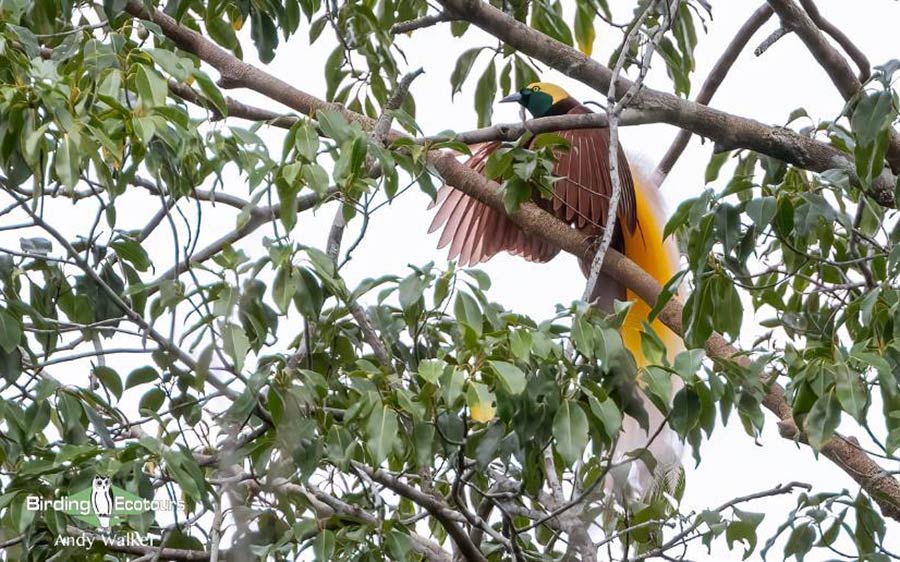
The simply spectacular Greater Bird-of-paradise gave a glorious display for us.
Day 5, 23rd August 2023. Birding the Kiunga area
We had a great day birding near Kiunga and racked up a long list of wonderful birds during our morning and afternoon birding sessions, including lots of gorgeous fruit doves, parrots, and some more birds-of-paradise too. Trumpet Manucode, Glossy-mantled Manucode, Greater Bird-of-paradise, King Bird-of-paradise, and Magnificent Riflebird were all seen (though some of these only briefly). Further color was provided by several stunning pigeons, including Wompoo Fruit Dove, Pink-spotted Fruit Dove, Superb Fruit Dove, Beautiful Fruit Dove, Orange-bellied Fruit Dove, and Dwarf Fruit Dove. Parrots ranged from the humongous Palm Cockatoo to the miniscule Yellow-capped Pygmy Parrot and many in between, such as Sulphur-crested Cockatoo, Papuan Eclectus, Red-cheeked Parrot, Red-flanked Lorikeet, Black-capped Lory, Dusky-cheeked Fig Parrot, and Double-eyed Fig Parrot. Several honeyeaters were seen, including Meyer’s Friarbird, and a wide range of other species, including multiple cuckooshrikes, Yellow-billed Kingfisher, cuckoos including Ivory-billed Coucal, Dwarf Koel, and Brush Cuckoo, Golden Monarch, Papuan Babbler, Papuan Spine-tailed Swift, Lowland Peltops, and possibly one of the flashiest of them all – Flame Bowerbird!
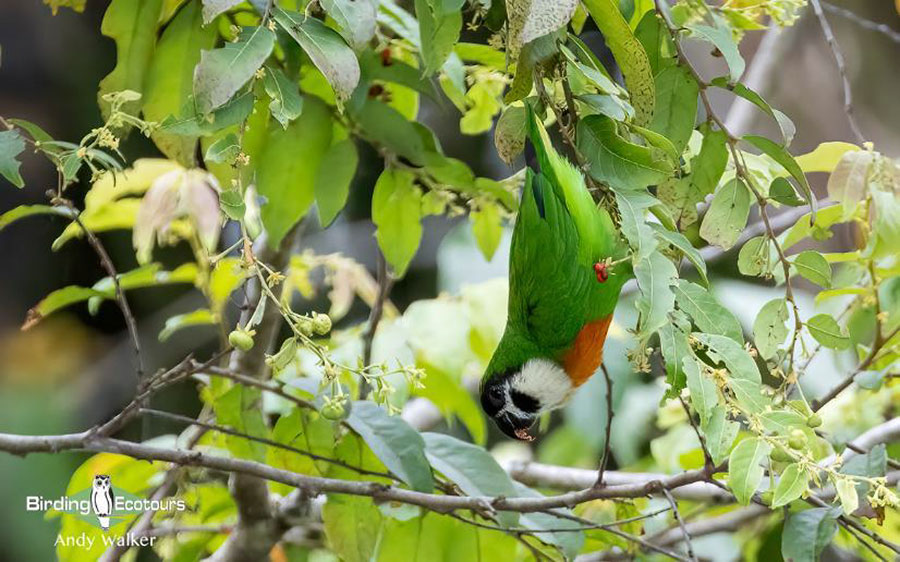
The gorgeous Dusky-cheeked Fig Parrot (formerly called Orange-breasted Fig Parrot) showed well during the tour.
Day 6, 24th August 2023. Birding the Kwatu Lodge area
We left Kiunga after breakfast and took a boat trip along three different rivers to reach the remote and basic Kwatu Lodge. It was a fascinating journey giving us a glimpse of remote life in the region, especially when we explored Gusiore village. As we made our boat ride along Fly River, Elavala River, and Ketu River we found Collared Imperial Pigeon, Pinon’s Imperial Pigeon, Pink-spotted Fruit Dove, Orange-bellied Fruit Dove, Pacific Koel, Channel-billed Cuckoo, White-bellied Sea Eagle, Palm Cockatoo, Yellow-streaked Lory, Papuan Hanging Parrot, Rufous-bellied Kookaburra, Hooded Pitta, Glossy-mantled Manucode, Trumpet Manucode, Grey Crow, Emperor Fairywren, and Shining Flycatcher.
Some fruiting trees around Kwatu Lodge, our remote base for the night, held Pink-spotted Fruit Dove, Orange-bellied Fruit Dove, Red-cheeked Parrot, Dusky-cheeked Fig Parrot, Double-eyed Fig Parrot, Large Fig Parrot, and Metallic Starling. We enjoyed some time just sitting and watching the birds come to us, for a change!
In the afternoon our boat ride yielded excellent views of Oriental Dollarbird, Papuan Spine-tailed Swift, Azure Kingfisher, Sacred Kingfisher, and Rufous-bellied Kookaburra. We then visited a quiet and unexplored patch of forest, where we got great views of Little Paradise Kingfisher, Common Paradise Kingfisher, Hook-billed Kingfisher, White-bellied Pitohui, Golden Cuckooshrike, and Frilled Monarch. As we took the boat back to the lodge in the late afternoon, we saw a distant Twelve-wired Bird-of-paradise briefly, along with Rufous-bellied Kookaburra, Sacred Kingfisher, and Black-capped Lory. Then the rain started, and it poured down for most of the night.
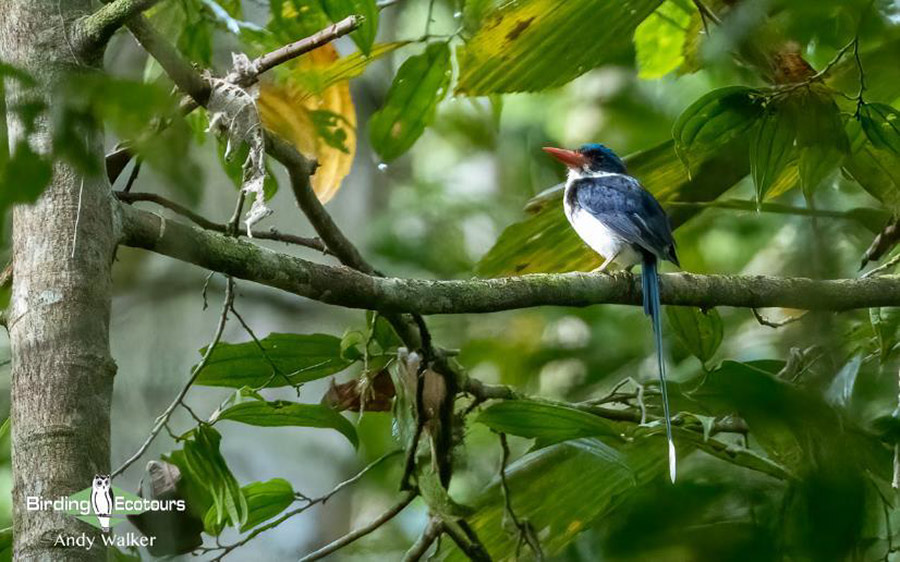
We got some great views of Little Paradise Kingfisher while birding near Kwatu Lodge and a short while later also saw Common Paradise Kingfisher, which allowed for a good comparison.
Day 7, 25th August 2023. Birding the Kwatu Lodge area
We awoke to find the Ketu River water level had increased massively overnight. We enjoyed a memorable early morning birding session right off Kwatu Lodge, where we found a flock of at least five roosting Sclater’s Crowned Pigeons, these huge, attractive, and uncommon giant pigeons were a highly sought-after target and a real joy to see, even in the half light of dawn. We then moved a bit further along the river where we found the simply spectacular Twelve-wired Bird-of-paradise and a short while later we were watching him go about a rather impressive bout of displaying. Two top birds right from the get-go!
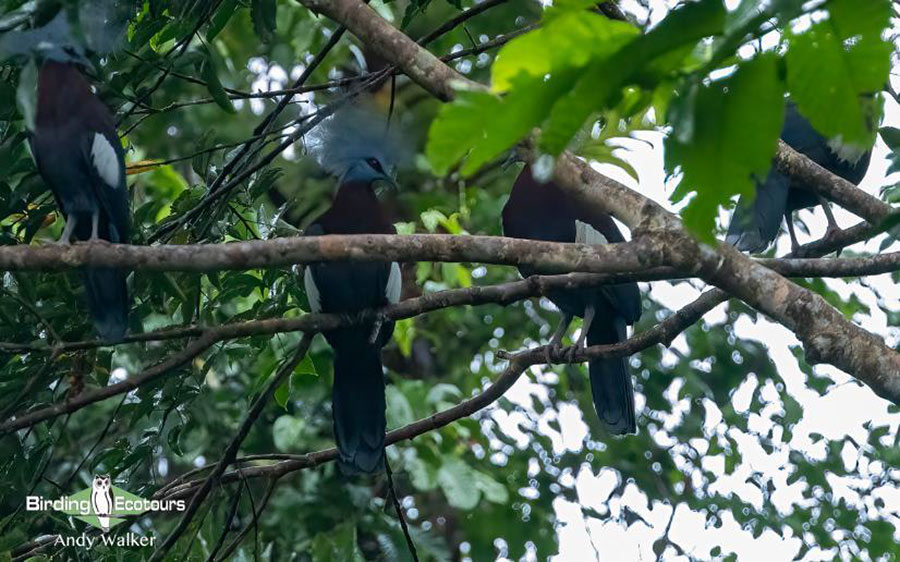
A flock of Sclater’s Crowned Pigeons that had been roosting together. What an incredible sight, even in the near darkness!
After enjoying our two big targets we tried for a few other birds, but the rain soon started up again and remained heavy for a while longer. Despite the rain, we managed to see a Black-sided Robin and improve our views of Emperor Fairywren before the rain got even heavier and we retreated to Kwatu Lodge for some shelter and a hot drink. While waiting for an early lunch and during intermittent short dry spells, we focused our attention on the fruiting trees around the lodge, and in doing so found Pink-spotted Fruit Dove, Orange-bellied Fruit Dove, Amboyna Cuckoo-Dove, Pacific Koel, Large Fig Parrot, Dusky-cheeked Fig Parrot, Red-flanked Lorikeet, Palm Cockatoo, Red-cheeked Parrot, Boyer’s Cuckooshrike, Grey-headed Cuckooshrike, Golden Cuckooshrike, Black Cicadabird, Varied Triller, New Guinea Friarbird, Metallic Starling, and a young Raggiana Bird-of-paradise. It was a great way to spend an enforced weather break.

The remarkable sight of a displaying Twelve-wired Bird-of-paradise.
After lunch it was time to get the boat back to Kiunga, however before that, since the rain had paused for a brief spell, we decided to try for one more bird that we had to abort looking for earlier due to the weather. After a sterling effort by our local team, we were able to get into position to see a gorgeous male King Bird-of-paradise at close range and low down. Satisfied with our haul from the river, we continued back to town (spotting another Raggiana Bird-of-paradise along the way). We arrived back at our accommodation in Kiunga and all enjoyed hot showers after our night in the jungle, but what a wonderful experience we’d had, packed full of great memories.
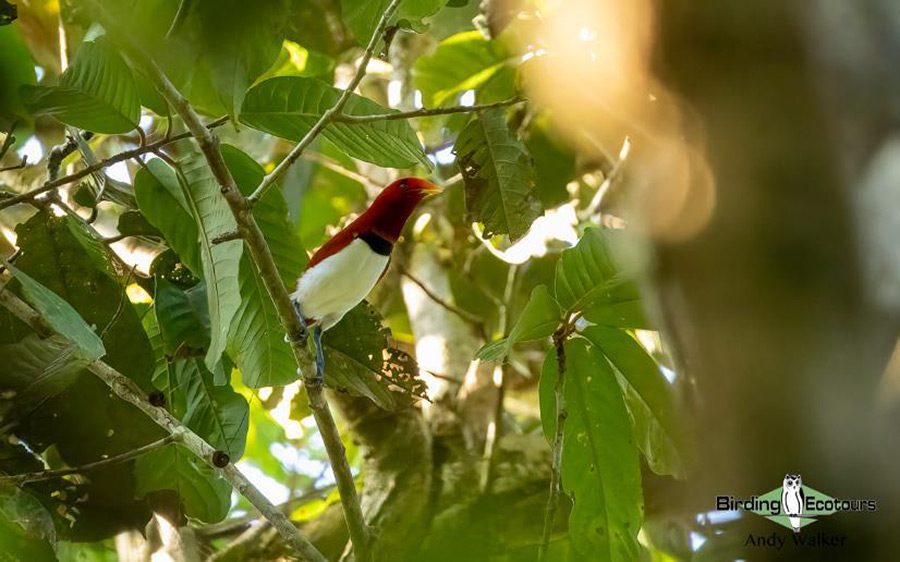
King Bird-of-paradise flew in and showed low down and well for us, although briefly.
Day 8, 26th August 2023. Transfer between Kiunga and Port Moresby
We enjoyed a relaxed breakfast and took our late morning flight from Kiunga (where the Australian Pratincoles were still in attendance) back to Port Moresby, where we spent the rest of the day at leisure and preparing for our next Papua New Guinea wilderness birding adventure.
Day 9, 27th August 2023. Transfer between Port Moresby and Mt Hagen
We had a morning flight from Port Moresby to Mt Hagen and then took the short drive to the picturesque Rondon Ridge Lodge, our base for the night. After lunch we explored the lodge, our first birding in the Papuan New Guinea Central Highlands, and found plenty of great birds, including three new birds-of-paradise, firstly Princess Stephanie’s Astrapia, secondly Greater Lophorina, and finally, the incomparable Blue Bird-of-paradise (it was “just” a female, but was still spectacular).

This gorgeous female Blue Bird-of-paradise gave great prolonged views while feeding.
While watching the birds-of-paradise we also saw Stella’s Lorikeet, Yellow-browed Melidectes, Common Smoky Honeyeater, Red-collared Myzomela, Brown-breasted Gerygone, White-shouldered Fairywren, Red-capped Flowerpecker, Pied Bush Chat, Long-tailed Shrike, and Hooded Mannikin.
Day 10, 28th August 2023. Birding Rondon Ridge and Kumul Lodge
We had a wonderful day birding in the highlands with so many highlight birds to choose from. During the morning we took a walk up from Rondon Ridge Lodge to Rondon Ridge itself. It was a moderately tough hike (especially given all the rainfall overnight), uphill all the way, but the birds at the top sure made the effort worthwhile. The pick of the birds included adult males of five simply spectacular birds-of-paradise: King of Saxony Bird-of-paradise (see the trip report cover image), Princess Stephanie’s Astrapia (see photo in the trip report introduction), Brown Sicklebill, Black Sicklebill, and a bit lower down the mountain, a male Greater Lophorina, finally.
While our focus was on the above birds-of-paradise and the hike itself (the trail was rather slippery), we noted a few other good species along the way, including Brown-backed Whistler, Sclater’s Whistler, Mid-mountain Berrypecker, Fan-tailed Berrypecker, Papuan Sittella, Island Leaf Warbler, Black-fronted White-eye, Papuan White-eye, Yellow-browed Melidectes, Ornate Melidectes, Common Smoky Honeyeater, Rufous-throated Bronze Cuckoo, Papuan Mountain Pigeon, Buff-faced Scrubwren, Papuan Scrubwren, Dimorphic Fantail, and Friendly Fantail.
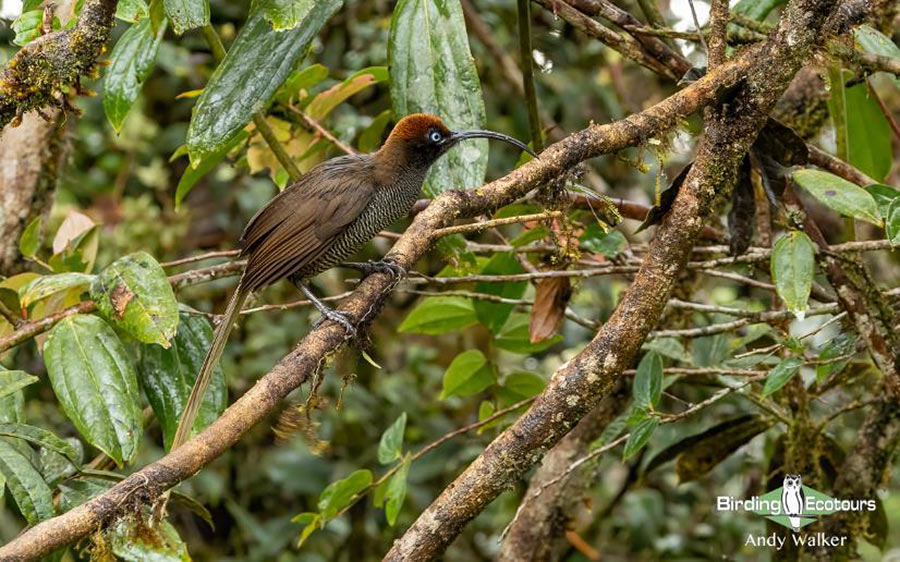
Brown Sicklebill is another huge bird-of-paradise that gave excellent views during the tour. It was great to be able to compare this species with its close relative, the Black Sicklebill while both species fed in the same fruiting tree, along with Princess Stephanie’s Astrapia (all with King of Saxony Bird-of-paradise displaying in the tree above them)!
After lunch we took an informative drive across to the famous Kumul Lodge with our local team filling us in about all things Papua New Guinea. We noted Long-tailed Shrike, Pied Bush Chat, and Black Kite along the way.

Even without its long tail, Ribbon-tailed Astrapia is still an incredibly beautiful bird-of-paradise.
We arrived at Kumul Lodge in the middle of the afternoon and spent a few hours at the exceptional bird feeders. It was rather wet and cool, but plenty of birds were in attendance at the feeders, with several new trip birds seen, including another new bird-of-paradise – the gorgeous Ribbon-tailed Astrapia. Unfortunately, the two adult males had dropped (molted) their long tail feathers, but they still looked rather resplendent, and the females were impressive too, as they busily fed their fledged young. Brown Sicklebills were numerous and gave very close views, while also feeding young. Other species noted at the Kumul Lodge bird feeders included Brehm’s Tiger Parrot, Stella’s Lorikeet, Orange-billed Lorikeet, Island (Papuan) Thrush, White-winged Robin, Belford’s Melidectes, Common Smoky Honeyeater, and Friendly Fantail.
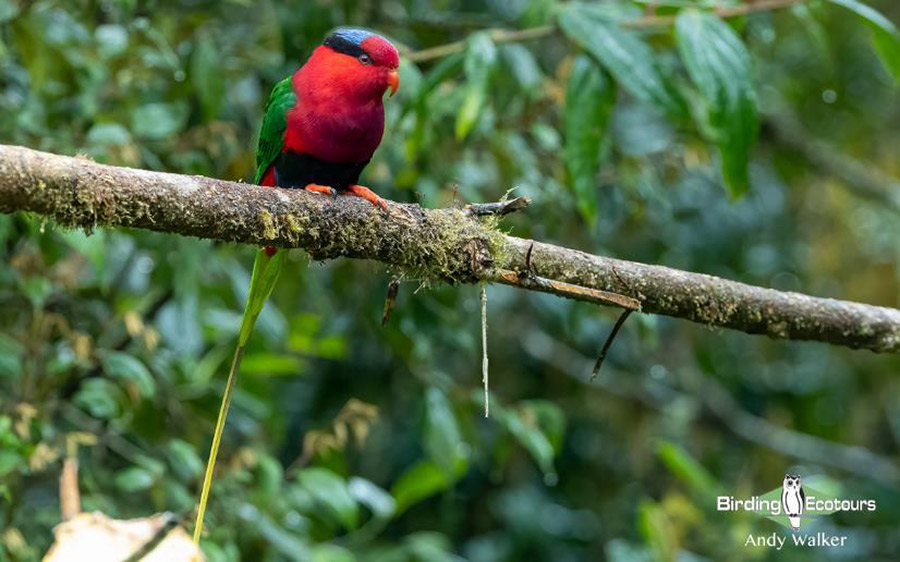
The rather colorful Stella’s Lorikeet gave us some great views at the Kumul Lodge bird feeders, and we also saw some of the dark-morph birds while birding in the nearby forest.
Day 11, 29th August 2023. Birding the Kumul Lodge area
We spent the morning birding near Kumul Lodge and after a short drive we took a steep hike up a gravel track to a specific spot to overlook a male Blue Bird-of-paradise display site. Unfortunately, we didn’t get to see any display activity, but we did get to watch the incredible male coming to a tree to feed a couple of times, giving prolonged views. Other birds distracting us while we waited for our target bird-of-paradise, included Mountain Kingfisher, Fan-tailed Cuckoo, Stout-billed Cuckooshrike, Bar-tailed Cuckoo-Dove, Rufous-backed Honeyeater, Yellow-browed Melidectes, and Common Smoky Honeyeater.
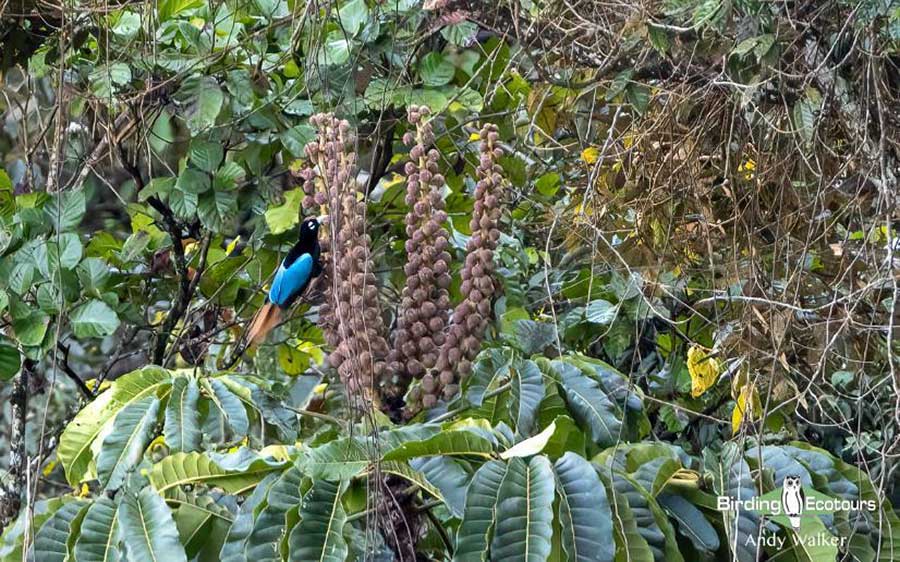
An adult male Blue Bird-of-paradise busy feeding.
The drive back to the lodge gave us a sighting of Brown Falcon and then during the latter part of the morning we birded around Kumul Lodge, finding a pair of the famous Blue-capped Ifrit (a monotypic family and a poisonous bird too!). Strolling around the grounds we also found Eastern Crested Berrypecker, Tit Berrypecker, Mountain Mouse-warbler, Canary Flyrobin, White-winged Robin, Painted Tiger Parrot, and dark-morph Stella’s Lorikeet. The usual birds were present at the feeders and included Brown Sicklebill, Ribbon-tailed Astrapia, Rufous-naped Bellbird, Belford’s Melidectes, and Brehm’s Tiger Parrot among others.

The Blue-capped Ifrit, showing its blue cap!
In the afternoon we visited a different patch of forest and enjoyed loads of great birds, such as Loria’s Satinbird, Mottled Berryhunter, Lesser Melampitta, Blue-capped Ifrit, Tit Berrypecker, Eastern Crested Berrypecker, Streaked Berrypecker, Rufous-backed Honeyeater, Brehm’s Tiger Parrot, Plum-faced Lorikeet, and Orange-billed Lorikeet. We also enjoyed further sightings of King of Saxony Bird-of-paradise, Princess Stephanie’s Astrapia, and Brown Sicklebill. Wattled Ploughbill was unfortunately only heard calling in the distance, but we couldn’t be too disappointed with all the fantastic birds we had just seen.

Brehm’s Tiger Parrot giving close views at the famous Kumul Lodge bird feeders.
Day 12, 30th August 2023. Kumul Lodge to Port Moresby
We had a brief morning walk around Kumul Lodge before it was time to drive back to Mt. Hagen and catch our flight back to Port Moresby. The morning walk was rather quiet, with the birds seemingly taking a while to warm up. We did however note a few good birds, such as Lesser Melampitta, Black-mantled Goshawk, Ribbon-tailed Astrapia, and Brown Sicklebill. We then took our afternoon flight back to Port Moresby and spent the remainder of the afternoon relaxing at our comfortable hotel.
Day 13, 31st August 2023. Birding Varirata National Park
We had a great day birding at Varirata National Park, a fantastic birding site near Port Moresby. The first bird we saw was one of our main targets, the national bird of Papua New Guinea, Raggiana Bird-of-paradise. We enjoyed watching six males displaying (see photo in trip report summary section), even though no females came in – yet another beautiful bird-of-paradise. After the bird-of-paradise-watching we relocated to a different part of the site, and in no time at all were watching two Brown-headed Paradise Kingfishers, an adult and a juvenile bird. After seeing these two target species, we walked along a road finding lots of other birds, such as Hooded Pitohui, Common Cicadabird, Barred Cuckooshrike, Black Cicadabird, Brown Oriole, Frilled Monarch, Grey Whistler, and Elegant Honeyeater.
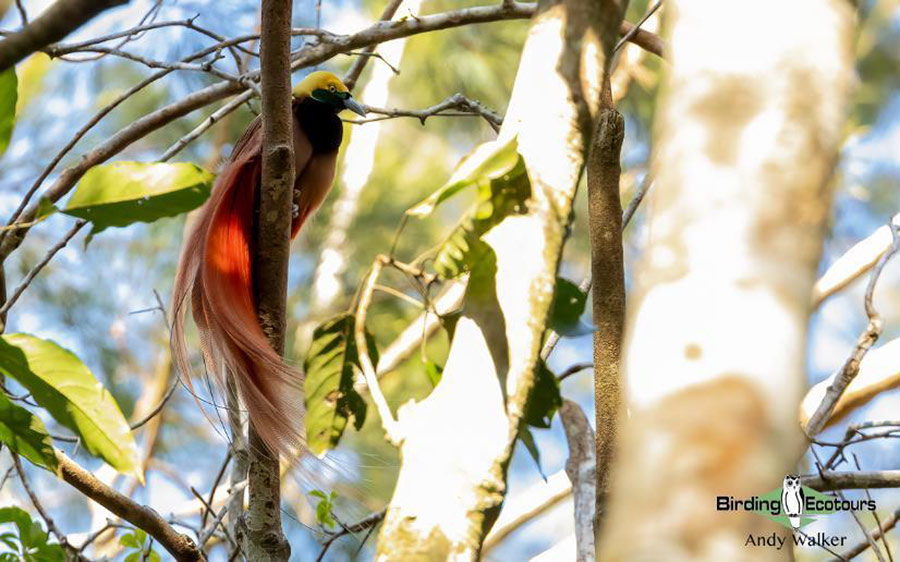
Getting close views of the simply stunning Raggiana Bird-of-paradise was another highlight.
We changed areas within the park again and found ourselves watching a couple of fruiting trees, where we noted Beautiful Fruit Dove, Pink-spotted Fruit Dove, Orange-bellied Fruit Dove, Superb Fruit Dove, Papuan King Parrot, Red-cheeked Parrot, Buff-faced Pygmy Parrot, and several other species. In the undergrowth we found Rusty Pitohui and in the trees in open woodland found Hooded Pitohui, Spangled Drongo, Rufous-bellied Kookaburra, Blue-winged Kookaburra, Yellow-faced Myna, Boyer’s Cuckooshrike, and more. Not too far from the fruiting trees we found roosting Barking Owl and Barred Owlet-nightjar, as well as nesting Papuan Frogmouth. Overhead we had Pacific Baza, Brahminy Kite, Gurney’s Eagle, Brown Goshawk, Torresian Crow, and Grey Crow.

We saw this adult Brown-headed Paradise Kingfisher while birding at Varirata National Park.
We then took a walk along a river and continued finding quality birds, including Crinkle-collared Manucode, Growling Riflebird, Purple-tailed Imperial Pigeon, Papuan Dwarf Kingfisher, Spectacled Longbill, White-faced Robin, Yellow-legged Flyrobin, Olive Flyrobin, Fairy Gerygone, Green-backed Gerygone, and Yellow-belied Gerygone.
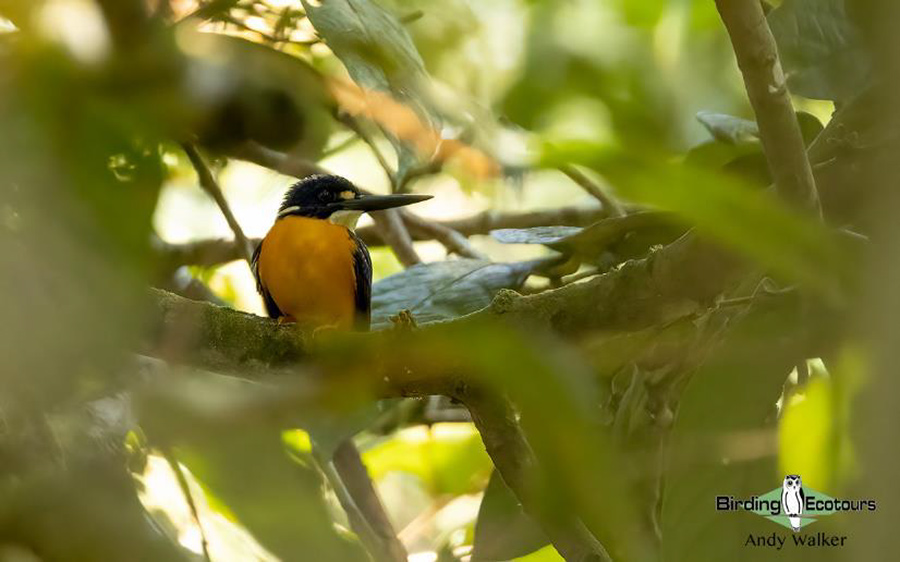
Papuan Dwarf Kingfisher showed well during our afternoon river walk.
Day 14, 1st September 2023. Transfer between Port Moresby and Tari, and travel to Ambua Lodge
We took a morning flight from Port Moresby to Tari in the Papua New Guinea Western Highlands. On arrival in Tari, we took the short journey to Ambua Lodge, our base for the next two nights. After lunch we commenced our birding in the area, finding King of Saxony Bird-of-paradise, Brown Sicklebill, Ribbon-tailed Astrapia, Black-bellied Cuckooshrike, Grey Thornbill, Rufous-backed Honeyeater, and a few other species, though in general it was rather quiet.
Day 15, 2nd September 2023. Birding Ambua Lodge and the Tari Gap area
We spent the morning birding the Tari Gap area above Ambua Lodge and connected with some great birds. Some of the highlights included Ribbon-tailed Astrapia, King of Saxony Bird-of-paradise, Brown Sicklebill, Black-billed Sicklebill, Lesser Melampitta, Loria’s Satinbird, MacGregor’s Bowerbird, Stella’s Lorikeet, Josephine’s Lorikeet, Goldie’s Lorikeet, Alpine Pipit, Eastern Crested Berrypecker, Fan-tailed Berrypecker, Mid-mountain Berrypecker, Dimorphic Fantail, Friendly Fantail, Fan-tailed Cuckoo, Island (Papuan) Thrush, Papuan Grassbird, Rufous-backed Honeyeater, Grey-streaked Honeyeater, Black-throated Honeyeater, Belford’s Melidectes, Yellow-browed Melidectes, and Regent Whistler.
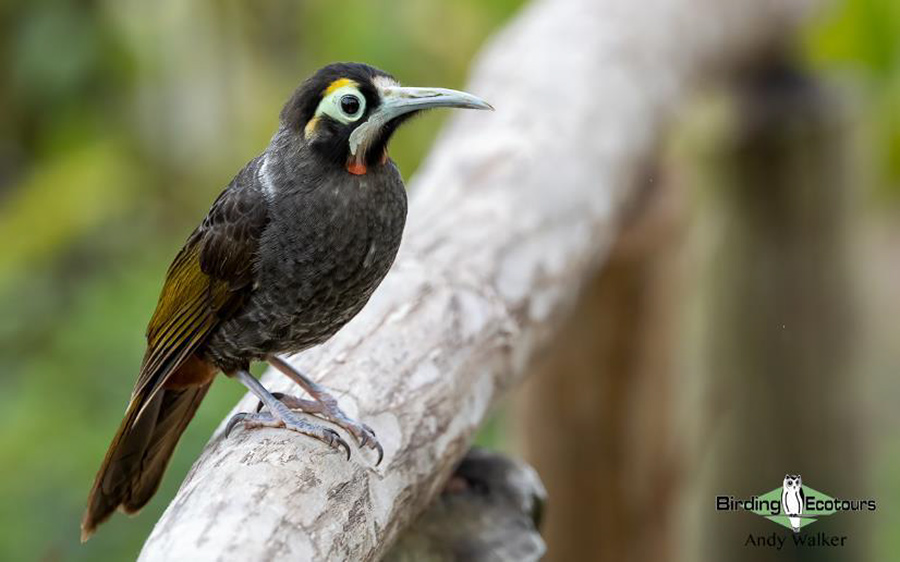
Yellow-browed Melidectes is a large honeyeater and it is rather brash and noisy!
In the afternoon the clouds descended but the rain held off allowing us some birding time. We found a nice mixed flock and some more birds-of-paradise, including Ribbon-tailed Astrapia, Short-tailed Paradigalla, Brown Sicklebill, and King of Saxony Bird-of-paradise. Other birds noted during the course of the afternoon included Capped White-eye, Large Scrubwren, Buff-faced Scrubwren, Grey Thornbill, Brown-breasted Gerygone, Black-breasted Boatbill, Mid-mountain Berrypecker, Black-bellied Cuckooshrike, Great Woodswallow, and Loria’s Satinbird.
Day 16, 3rd September 2023. Transfer from Tari to Port Moresby
The original plan was for another day’s birding in the Ambua area, however just before the tour commenced, Air Niugini changed their flight schedules between Tari and Port Moresby, meaning we had to make some last-minute changes to our tour route. After a late breakfast, we made our way from the picturesque Ambua Lodge back to Tari. From Tari we took our flight back to Port Moresby, for the final group evening meal together.
Day 17, 4th September 2023. Port Moresby birding and departure
We had a final morning birding in the excellent Pacific Adventist University grounds, not far outside of Port Moresby city. We added plenty of new trip birds here, including Orange-fronted Fruit Dove, Bar-shouldered Dove, Australian Hobby, Fawn-breasted Bowerbird, Rufous-banded Honeyeater, White-bellied Cuckooshrike, Black-backed Butcherbird, Australasian Figbird, Golden-headed Cisticola, Singing Starling, and Grey-headed Mannikin.
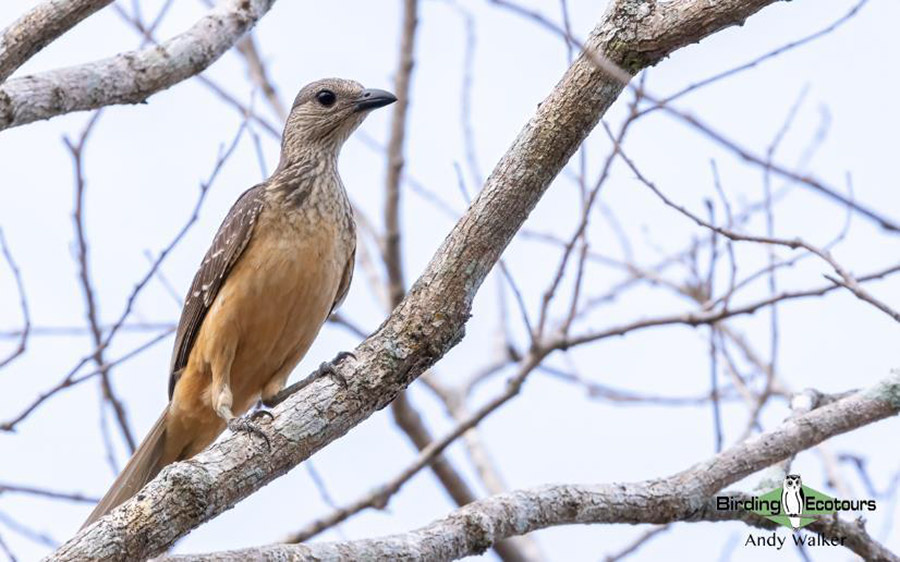
We enjoyed excellent views of multiple Fawn-breasted Bowerbirds on our final day of birding in Papua New Guinea.
During our morning birding session, we also found several new waterfowl species, including Wandering Whistling Duck, Radjah Shelduck, Pacific Black Duck, Grey Teal, Pied Heron, Australasian Darter, Little Pied Cormorant, Little Black Cormorant, Australasian Swamphen, Dusky Moorhen, and Comb-crested Jacana. On finishing our birding and returning to Port Moresby, this Papua New Guinea birding tour ended.
Bird List – Following IOC (13.2)
Birds ‘heard only’ are marked with (H) after the common name, all other species were seen. The following notation after species names is used to show conservation status following BirdLife International: VU = Vulnerable.
| Common Name | Scientific Name |
| Ducks, Geese, Swans (Anatidae) | |
| Wandering Whistling Duck | Dendrocygna arcuata |
| Radjah Shelduck | Radjah radjah |
| Salvadori’s Teal | Salvadorina waigiuensis |
| Pacific Black Duck | Anas superciliosa |
| Grey Teal | Anas gracilis |
| Megapodes (Megapodiidae) | |
| Black-billed Brushturkey (H) | Talegalla fuscirostris |
| Orange-footed Scrubfowl | Megapodius reinwardt |
| Pheasants & Allies (Phasianidae) | |
| Brown Quail | Synoicus ypsilophorus |
| Frogmouths (Podargidae) | |
| Marbled Frogmouth (H) | Podargus ocellatus |
| Papuan Frogmouth | Podargus papuensis |
| Owlet-nightjars (Aegothelidae) | |
| Barred Owlet-nightjar | Aegotheles bennettii |
| Treeswifts (Hemiprocnidae) | |
| Moustached Treeswift | Hemiprocne mystacea |
| Swifts (Apodidae) | |
| Glossy Swiftlet | Collocalia esculenta |
| Mountain Swiftlet | Aerodramus hirundinaceus |
| Uniform Swiftlet | Aerodramus vanikorensis |
| Papuan Spine-tailed Swift | Mearnsia novaeguineae |
| Cuckoos (Cuculidae) | |
| Ivory-billed Coucal | Centropus menbeki |
| Pheasant Coucal | Centropus phasianinus |
| Dwarf Koel | Microdynamis parva |
| Pacific Koel | Eudynamys orientalis |
| Channel-billed Cuckoo | Scythrops novaehollandiae |
| Rufous-throated Bronze Cuckoo | Chrysococcyx ruficollis |
| Shining Bronze Cuckoo (H) | Chrysococcyx lucidus |
| White-crowned Cuckoo | Cacomantis leucolophus |
| Chestnut-breasted Cuckoo | Cacomantis castaneiventris |
| Fan-tailed Cuckoo | Cacomantis flabelliformis |
| Brush Cuckoo | Cacomantis variolosus |
| Pigeons, Doves (Columbidae) | |
| Rock Dove | Columba livia |
| Amboyna Cuckoo-Dove | Macropygia amboinensis |
| Bar-tailed Cuckoo-Dove | Macropygia nigrirostris |
| Great Cuckoo-Dove | Reinwardtoena reinwardti |
| Pacific Emerald Dove | Chalcophaps longirostris |
| Stephan’s Emerald Dove | Chalcophaps stephani |
| Peaceful Dove | Geopelia placida |
| Bar-shouldered Dove | Geopelia humeralis |
| Cinnamon Ground Dove (H) | Gallicolumba rufigula |
| Sclater’s Crowned Pigeon | Goura sclaterii |
| Wompoo Fruit Dove | Ptilinopus magnificus |
| Pink-spotted Fruit Dove | Ptilinopus perlatus |
| Ornate Fruit Dove | Ptilinopus ornatus |
| Orange-fronted Fruit Dove | Ptilinopus aurantiifrons |
| Superb Fruit Dove | Ptilinopus superbus |
| Beautiful Fruit Dove | Ptilinopus pulchellus |
| White-bibbed Fruit Dove | Ptilinopus rivoli |
| Orange-bellied Fruit Dove | Ptilinopus iozonus |
| Dwarf Fruit Dove | Ptilinopus nainus |
| Purple-tailed Imperial Pigeon | Ducula rufigaster |
| Pinon’s Imperial Pigeon | Ducula pinon |
| Collared Imperial Pigeon | Ducula mullerii |
| Zoe’s Imperial Pigeon | Ducula zoeae |
| Torresian Imperial Pigeon | Ducula spilorrhoa |
| Papuan Mountain Pigeon | Gymnophaps albertisii |
| Rails, Crakes & Coots (Rallidae) | |
| Buff-banded Rail | Hypotaenidia philippensis |
| Dusky Moorhen | Gallinula tenebrosa |
| Australasian Swamphen | Porphyrio melanotus |
| Pale-vented Bush-hen | Amaurornis moluccana |
| Plovers (Charadriidae) | |
| Masked Lapwing | Vanellus miles |
| Jacanas (Jacanidae) | |
| Comb-crested Jacana | Irediparra gallinacea |
| Sandpipers, Snipes (Scolopacidae) | |
| Common Sandpiper | Actitis hypoleucos |
| Coursers, Pratincoles (Glareolidae) | |
| Australian Pratincole | Stiltia isabella |
| Anhingas, Darters (Anhingidae) | |
| Australasian Darter | Anhinga novaehollandiae |
| Cormorants, Shags (Phalacrocoracidae) | |
| Little Pied Cormorant | Microcarbo melanoleucos |
| Little Black Cormorant | Phalacrocorax sulcirostris |
| Ibises, Spoonbills (Threskiornithidae) | |
| Australian White Ibis | Threskiornis molucca |
| Herons, Bitterns (Ardeidae) | |
| Nankeen Night Heron | Nycticorax caledonicus |
| Striated Heron | Butorides striata |
| Eastern Cattle Egret | Bubulcus coromandus |
| Great Egret | Ardea alba |
| Intermediate Egret | Ardea intermedia |
| Pied Heron | Egretta picata |
| Little Egret | Egretta garzetta |
| Kites, Hawks, Eagles (Accipitridae) | |
| Pacific Baza | Aviceda subcristata |
| Long-tailed Honey Buzzard | Henicopernis longicauda |
| Gurney’s Eagle | Aquila gurneyi |
| Variable Goshawk | Accipiter hiogaster |
| Brown Goshawk | Accipiter fasciatus |
| Black-mantled Goshawk | Accipiter melanochlamys |
| Grey-headed Goshawk | Accipiter poliocephalus |
| Papuan Harrier | Circus spilothorax |
| Black Kite | Milvus migrans |
| Whistling Kite | Haliastur sphenurus |
| Brahminy Kite | Haliastur indus |
| White-bellied Sea Eagle | Haliaeetus leucogaster |
| Owls (Strigidae) | |
| Barking Owl | Ninox connivens |
| Papuan Boobook | Ninox theomacha |
| Hornbills (Bucerotidae) | |
| Blyth’s Hornbill | Rhyticeros plicatus |
| Rollers (Coraciidae) | |
| Oriental Dollarbird | Eurystomus orientalis |
| Kingfishers (Alcedinidae) | |
| Hook-billed Kingfisher | Melidora macrorrhina |
| Common Paradise Kingfisher | Tanysiptera galatea |
| Little Paradise Kingfisher | Tanysiptera hydrocharis |
| Brown-headed Paradise Kingfisher | Tanysiptera danae |
| Shovel-billed Kookaburra (H) | Dacelo rex |
| Rufous-bellied Kookaburra | Dacelo gaudichaud |
| Blue-winged Kookaburra | Dacelo leachii |
| Sacred Kingfisher | Todiramphus sanctus |
| Yellow-billed Kingfisher | Syma torotoro |
| Mountain Kingfisher | Syma megarhyncha |
| Common Kingfisher | Alcedo atthis |
| Papuan Dwarf Kingfisher | Ceyx solitarius |
| Azure Kingfisher | Ceyx azureus |
| Bee-eaters (Meropidae) | |
| Rainbow Bee-eater | Merops ornatus |
| Caracaras, Falcons (Falconidae) | |
| Australian Hobby | Falco longipennis |
| Brown Falcon | Falco berigora |
| Cockatoos (Cacatuidae) | |
| Palm Cockatoo | Probosciger aterrimus |
| Sulphur-crested Cockatoo | Cacatua galerita |
| Old World Parrots (Psittaculidae) | |
| Pesquet’s Parrot (H) – VU | Psittrichas fulgidus |
| Yellow-capped Pygmy Parrot | Micropsitta keiensis |
| Buff-faced Pygmy Parrot | Micropsitta pusio |
| Red-breasted Pygmy Parrot | Micropsitta bruijnii |
| Papuan King Parrot | Alisterus chloropterus |
| Papuan Eclectus | Eclectus polychloros |
| Red-cheeked Parrot | Geoffroyus geoffroyi |
| Blue-collared Parrot | Geoffroyus simplex |
| Brehm’s Tiger Parrot | Psittacella brehmii |
| Painted Tiger Parrot | Psittacella picta |
| Plum-faced Lorikeet | Oreopsittacus arfaki |
| Pygmy Lorikeet | Charminetta wilhelminae |
| Red-flanked Lorikeet | Hypocharmosyna placentis |
| Fairy Lorikeet | Charmosynopsis pulchella |
| Josephine’s Lorikeet | Charmosyna josefinae |
| Stella’s Lorikeet | Charmosyna stellae |
| Orange-billed Lorikeet | Neopsittacus pullicauda |
| Black-capped Lory | Lorius lory |
| Dusky Lory | Pseudeos fuscata |
| Yellow-streaked Lory | Chalcopsitta scintillata |
| Goldie’s Lorikeet | Glossoptilus goldiei |
| Coconut Lorikeet | Trichoglossus haematodus |
| Large Fig Parrot | Psittaculirostris desmarestii |
| Dusky-cheeked Fig Parrot | Cyclopsitta melanogenia |
| Double-eyed Fig Parrot | Cyclopsitta diophthalma |
| Orange-fronted Hanging Parrot | Loriculus aurantiifrons |
| Pittas (Pittidae) | |
| Papuan Pitta (H) | Erythropitta macklotii |
| Hooded Pitta | Pitta sordida |
| Bowerbirds (Ptilonorhynchidae) | |
| Ochre-breasted Catbird (H) | Ailuroedus stonii |
| MacGregor’s Bowerbird | Amblyornis macgregoriae |
| Flame Bowerbird | Sericulus ardens |
| Fawn-breasted Bowerbird | Chlamydera cerviniventris |
| Australasian Wrens (Maluridae) | |
| Emperor Fairywren | Malurus cyanocephalus |
| White-shouldered Fairywren | Malurus alboscapulatus |
| Orange-crowned Fairywren | Clytomyias insignis |
| Honeyeaters (Meliphagidae) | |
| Sooty Honeyeater | Melionyx fuscus |
| Rufous-backed Honeyeater | Ptiloprora guisei |
| Grey-streaked Honeyeater | Ptiloprora perstriata |
| Rufous-banded Honeyeater | Conopophila albogularis |
| Long-billed Honeyeater | Melilestes megarhynchus |
| Common Smoky Honeyeater | Melipotes fumigatus |
| Plain Honeyeater | Pycnopygius ixoides |
| Ruby-throated Myzomela | Myzomela eques |
| Papuan Black Myzomela | Myzomela nigrita |
| Mountain Myzomela | Myzomela adolphinae |
| Red-collared Myzomela | Myzomela rosenbergii |
| Meyer’s Friarbird | Philemon meyeri |
| New Guinea Friarbird | Philemon novaeguineae |
| Tawny-breasted Honeyeater | Xanthotis flaviventer |
| Puff-backed Honeyeater | Meliphaga aruensis |
| Mountain Honeyeater | Microptilotis orientalis |
| Scrub Honeyeater | Microptilotis albonotatus |
| Mimic Honeyeater | Microptilotis analogus |
| Graceful Honeyeater | Microptilotis gracilis |
| Elegant Honeyeater | Microptilotis cinereifrons |
| Black-throated Honeyeater | Caligavis subfrenata |
| Obscure Honeyeater | Caligavis obscura |
| Yellow-browed Melidectes | Melidectes rufocrissalis |
| Belford’s Melidectes | Melidectes belfordi |
| Ornate Melidectes | Melidectes torquatus |
| Australasian Warblers (Acanthizidae) | |
| Rusty Mouse-warbler (H) | Origma murina |
| Mountain Mouse-warbler | Origma robusta |
| Pale-billed Scrubwren | Aethomyias spilodera |
| Buff-faced Scrubwren | Aethomyias perspicillatus |
| Papuan Scrubwren | Aethomyias papuensis |
| Large Scrubwren | Sericornis nouhuysi |
| Brown-breasted Gerygone | Gerygone ruficollis |
| Large-billed Gerygone | Gerygone magnirostris |
| Yellow-bellied Gerygone | Gerygone chrysogaster |
| Green-backed Gerygone | Gerygone chloronota |
| Fairy Gerygone | Gerygone palpebrosa |
| Grey Thornbill | Acanthiza cinerea |
| Australasian Babblers (Pomatostomidae) | |
| Papuan Babbler | Garritornis isidorei |
| Satinbirds (Cnemophilidae) | |
| Loria’s Satinbird | Cnemophilus loriae |
| Berrypeckers, Longbills (Melanocharitidae) | |
| Obscure Berrypecker | Melanocharis arfakiana |
| Mid-mountain Berrypecker | Melanocharis longicauda |
| Fan-tailed Berrypecker | Melanocharis versteri |
| Streaked Berrypecker | Melanocharis striativentris |
| Spotted Berrypecker | Rhamphocharis piperata |
| Spectacled Longbill | Oedistoma iliolophus |
| Yellow-bellied Longbill | Toxorhamphus novaeguineae |
| Painted Berrypeckers (Paramythiidae) | |
| Tit Berrypecker | Oreocharis arfaki |
| Eastern Crested Berrypecker | Paramythia montium |
| Jewel-babblers, Quail-thrushes (Cinclosomatidae) | |
| Blue Jewel-babbler (H) | Ptilorrhoa caerulescens |
| Chestnut-backed Jewel-babbler (H) | Ptilorrhoa castanonota |
| Boatbills (Machaerirhynchidae) | |
| Yellow-breasted Boatbill | Machaerirhynchus flaviventer |
| Black-breasted Boatbill | Machaerirhynchus nigripectus |
| Woodswallows, Butcherbirds & Allies (Artamidae) | |
| White-breasted Woodswallow | Artamus leucorynchus |
| Great Woodswallow | Artamus maximus |
| Lowland Peltops | Peltops blainvillii |
| Mountain Peltops | Peltops montanus |
| Black Butcherbird | Melloria quoyi |
| Black-backed Butcherbird | Cracticus mentalis |
| Hooded Butcherbird | Cracticus cassicus |
| Mottled Berryhunter (Rhagologidae) | |
| Mottled Berryhunter | Rhagologus leucostigma |
| Cuckooshrikes (Campephagidae) | |
| Stout-billed Cuckooshrike | Coracina caeruleogrisea |
| Hooded Cuckooshrike | Coracina longicauda |
| Barred Cuckooshrike | Coracina lineata |
| Black-faced Cuckooshrike | Coracina novaehollandiae |
| Boyer’s Cuckooshrike | Coracina boyeri |
| White-bellied Cuckooshrike | Coracina papuensis |
| Golden Cuckooshrike | Campochaera sloetii |
| Black-bellied Cuckooshrike | Edolisoma montanum |
| Grey-headed Cuckooshrike | Edolisoma schisticeps |
| Common Cicadabird | Edolisoma tenuirostre |
| Black Cicadabird | Edolisoma melas |
| Varied Triller | Lalage leucomela |
| Sittellas (Neosittidae) | |
| Papuan Sittella | Daphoenositta papuensis |
| Ploughbill (Eulacestomatidae) | |
| Wattled Ploughbill (H) | Eulacestoma nigropectus |
| Australo-Papuan Bellbirds (Oreoicidae) | |
| Rufous-naped Bellbird | Aleadryas rufinucha |
| Whistlers & Allies (Pachycephalidae) | |
| Brown-backed Whistler | Pachycephala modesta |
| Grey Whistler | Pachycephala simplex |
| Sclater’s Whistler | Pachycephala soror |
| Regent Whistler | Pachycephala schlegelii |
| Black-headed Whistler (H) | Pachycephala monacha |
| White-bellied Pitohui | Pseudorectes incertus |
| Rusty Pitohui | Pseudorectes ferrugineus |
| Arafura Shrikethrush | Colluricincla megarhyncha |
| Rufous Shrikethrush | Colluricincla rufogaster |
| Shrikes (Laniidae) | |
| Long-tailed Shrike | Lanius schach |
| Figbirds, Old World Orioles, Piopios (Oriolidae) | |
| Australasian Figbird | Sphecotheres vieilloti |
| Southern Variable Pitohui | Pitohui uropygialis |
| Hooded Pitohui | Pitohui dichrous |
| Brown Oriole | Oriolus szalayi |
| Drongos (Dicruridae) | |
| Spangled Drongo | Dicrurus bracteatus |
| Fantails (Rhipiduridae) | |
| Willie Wagtail | Rhipidura leucophrys |
| Black Fantail | Rhipidura atra |
| Chestnut-bellied Fantail | Rhipidura hyperythra |
| Friendly Fantail | Rhipidura albolimbata |
| Dimorphic Fantail | Rhipidura brachyrhyncha |
| Rufous-backed Fantail | Rhipidura rufidorsa |
| Monarchs (Monarchidae) | |
| Spot-winged Monarch | Symposiachrus guttula |
| Golden Monarch | Carterornis chrysomela |
| Frilled Monarch | Arses telescopthalmus |
| Torrent-lark | Grallina bruijnii |
| Shining Flycatcher | Myiagra alecto |
| Crows, Jays (Corvidae) | |
| Grey Crow | Corvus tristis |
| Torresian Crow | Corvus orru |
| Melampittas (Melampittidae) | |
| Lesser Melampitta | Melampitta lugubris |
| Ifrit (Ifritidae) | |
| Blue-capped Ifrit | Ifrita kowaldi |
| Birds-of-paradise (Paradisaeidae) | |
| Glossy-mantled Manucode | Manucodia ater |
| Crinkle-collared Manucode | Manucodia chalybatus |
| Trumpet Manucode | Phonygammus keraudrenii |
| Short-tailed Paradigalla | Paradigalla brevicauda |
| Splendid Astrapia | Astrapia splendidissima |
| Ribbon-tailed Astrapia | Astrapia mayeri |
| Princess Stephanie’s Astrapia | Astrapia stephaniae |
| Queen Carola’s Parotia | Parotia carolae |
| King of Saxony Bird-of-paradise | Pteridophora alberti |
| Greater Lophorina | Lophorina superba |
| Magnificent Riflebird | Ptiloris magnificus |
| Growling Riflebird | Ptiloris intercedens |
| Black Sicklebill | Epimachus fastosus |
| Brown Sicklebill | Epimachus meyeri |
| Black-billed Sicklebill | Drepanornis albertisi |
| Magnificent Bird-of-paradise | Diphyllodes magnificus |
| King Bird-of-paradise | Cicinnurus regius |
| Twelve-wired Bird-of-paradise | Seleucidis melanoleucus |
| Greater Bird-of-paradise | Paradisaea apoda |
| Raggiana Bird-of-paradise | Paradisaea raggiana |
| Blue Bird-of-paradise | Paradisornis rudolphi |
| Australasian Robins (Petroicidae) | |
| White-faced Robin | Tregellasia leucops |
| White-winged Robin | Peneothello sigillata |
| Slaty Robin | Peneothello cyanus |
| White-rumped Robin | Peneothello bimaculata |
| Black-sided Robin | Poecilodryas hypoleuca |
| Black-capped Robin (H) | Heteromyias armiti |
| Torrent Flyrobin | Monachella muelleriana |
| Yellow-legged Flyrobin | Kempiella griseoceps |
| Olive Flyrobin | Kempiella flavovirescens |
| Canary Flyrobin | Devioeca papuana |
| Swallows, Martins (Hirundinidae) | |
| Pacific Swallow | Hirundo tahitica |
| Barn Swallow | Hirundo rustica |
| Leaf Warblers (Phylloscopidae) | |
| Island Leaf Warbler | Phylloscopus poliocephalus |
| Reed Warblers & Allies (Acrocephalidae) | |
| Australian Reed Warbler | Acrocephalus australis |
| Grassbirds & Allies (Locustellidae) | |
| Papuan Grassbird | Cincloramphus macrurus |
| Cisticolas & Allies (Cisticolidae) | |
| Golden-headed Cisticola | Cisticola exilis |
| White-eyes (Zosteropidae) | |
| Black-fronted White-eye | Zosterops chrysolaemus |
| Capped White-eye | Zosterops fuscicapilla |
| Papuan White-eye | Zosterops novaeguineae |
| Starlings, Rhabdornises (Sturnidae) | |
| Metallic Starling | Aplonis metallica |
| Singing Starling | Aplonis cantoroides |
| Yellow-faced Myna | Mino dumontii |
| Golden Myna | Mino anais |
| Thrushes (Turdidae) | |
| Island Thrush | Turdus poliocephalus |
| Chats, Old World Flycatchers (Muscicapidae) | |
| Pied Bush Chat | Saxicola caprata |
| Flowerpeckers (Dicaeidae) | |
| Red-capped Flowerpecker | Dicaeum geelvinkianum |
| Sunbirds (Nectariniidae) | |
| Black Sunbird | Leptocoma aspasia |
| Olive-backed Sunbird | Cinnyris jugularis |
| Old World Sparrows, Snowfinches (Passeridae) | |
| Eurasian Tree Sparrow | Passer montanus |
| House Sparrow | Passer domesticus |
| Waxbills, Munias & Allies (Estrildidae) | |
| Grey-headed Mannikin | Lonchura caniceps |
| Hooded Mannikin | Lonchura spectabilis |
| Wagtails, Pipits (Motacillidae) | |
| Australian Pipit | Anthus australis |
| Alpine Pipit | Anthus gutturalis |
| Total seen | 286 |
| Total heard only | 14 |
| Total recorded | 300 |
Reptile List
| Common Name | Scientific Name |
| Austro-American Side-necked Turtles (Chelidae) | |
| Jardine River Turtle | Emydura subglobosa |
| Total | 1 |
Mammal List
| Common Name | Scientific Name |
| Old World Fruit Bats (Pteropodidae) | |
| Great Flying Fox | Pteropus neohibernicus |
| Dasyures (Dasyuridae) | |
| Speckled Dasyure | Neophascogale lorentzii |
| Deer (Cervidae) | |
| Javan Deer | Rusa timorensis |
| Total | 3 |
Butterfly and Moth List
| Common Name | Scientific Name |
| Emperor and Giant Silk Moths (Saturniidae) | |
| Hercules Moth | Coscinocera hercules |
| Swallowtails and Parnassians (Papilioninae) | |
| Common Green Birdwing | Ornithoptera priamus |
| Ulysses Butterfly | Papilio ulysses |
| Purple Spotted Swallowtail | Graphium weiskei |
| Brush-footed Butterflies (Nymphalidae) | |
| Great Eggfly | Hypolimnas bolina |
| Taenaris sp. | Taenaris cyclops |
| Total | 6 |
DOWNLOAD TRIP REPORT
This is a sample trip report. Please email us ([email protected]) for more trip reports from this destination.
Papua New Guinea: Birding Attenborough’s Paradise
Tour-specific Information
GENERAL INFORMATION ABOUT PAPUA NEW GUINEA CAN BE READ HERE
TOUR OUTLINE
This amazing, once-in-a-lifetime birding tour focuses on the multitude of endemic birds that can be found in Papua New Guinea (PNG) and this includes numerous simply spectacular birds-of-paradise (BoPs) including Blue Bird-of-paradise, King of Saxony Bird-of-paradise, Raggiana Bird-of-paradise, Twelve-wired Bird-of-paradise, King Bird-of-paradise, Queen Carola’s Parotia, Ribbon-tailed Astrapia, and Princess Stephanie’s Astrapia. Plenty of other highlights will also be found on what promises to be an amazing Papua New Guinea birding tour. This is just a tiny sample of what’s on offer on this tour, please refer to the detailed itinerary for further details. This tour starts and ends in Port Moresby.
DAILY ACTIVITIES, PHYSICAL REQUIREMENTS, AND TOUR PACE
This Papua New Guinea: Birding Attenborough’s Paradise tour requires reasonable physical fitness and good agility to bird the relatively steep slopes found here. Papua New Guinea is one of the most remote and undeveloped countries in the world, so remember you are visiting a developing country and will be staying in remote “wilderness” areas, where there are no proper sanitation facilities. Expect many things to be very different from home.
We will shift our body clocks on this tour, rising very early but sleeping early too. Most birding occurs on narrow, sometimes swampy forest trails, and other times we will bird from wider roads and tracks that are often uneven and can be slippery. On the trails care must be taken as there are trip and slip hazards from damp roots, fallen trees, boulders, and uneven and rough surfaces. Walking sticks or hiking poles are a great idea as they provide added stability to help with balance and are compulsory for anyone who is not steady at walking, and highly recommended for everyone, no matter of ability.
Most trails are graded and rated easy to moderate in terms of physical activity with not too much up and down, but at some locations they do occur at elevation (e.g., over 7,000 feet / 2,130 meters). Some walks we make will be short, e.g. ¼ of a mile (0.4 kilometers) while sometimes it may be further, such as up to 2 miles (3.2 kilometers). Our local team are excellent at helping those less physically able at getting around the trails and in position to view the birds as required. Much of our birding is carried out from our accommodation bases, so these walks can be optional if you’d like to take a rest for some of them (and there are often great birds around our accommodation). We have more than one chance for most of the birds-of-paradise (and other excellent birds) during the tour, so sitting a session out does not mean you will necessarily miss something totally.
At some locations we may spend time within small bird blinds (which are often not particularly comfortable and may entail sitting on the ground or small stools) to get close to the various birds-of-paradise’s lekking/display sites (and sometimes other items of interest such as bowerbird bowers). Any minor temporary discomfort will, however, likely be well worth it.
Note that in each year the specific locations of the birds-of-paradise lek sites may change due to numerous factors beyond our control. Sometimes birds can be found displaying next to nice easy access points with very limited and simple walking, but at other times they can be further away and take much more effort to reach, sometimes involving a walk on difficult terrain for a longer period. We will try and provide as much information ahead of each hike for each specific bird-of-paradise lek site/birding adventure to help you know what to expect and make any decisions on whether you want to miss a particular hike. When possible, we will take the easiest option, but sometimes the easiest option can also result in a fair bit of effort to reach. Sometimes at some locations we may find birds-of-paradise and other key birds in our accommodation gardens!
The information within this document and the Papua New Guinea general information linked from the top of document will hopefully help in your preparation for this tour and please do contact us if you have any requests for specific or further information. The local people here are incredibly proud of their forests and their birds, and they love to share these with us. Tourism in Papua New Guinea provides valuable income for the villagers and protects the forests for the birds and future generations.
We recommend that if you decide to join this tour (no matter your fitness level) that you work on your physical fitness prior to it, hiking up and down hills/steps is a good way to prepare.
TRANSPORTATION
We use a wide range of transport on the tour, and this will likely include (when around Port Moresby) 24-seater coaster buses and 15-seater vans limited to nine seats. We might also make use of similar vehicles when in more remote locations and likely also 4×4 vehicles (such as Toyota Hilux or similar). We require that you are fit and flexible and can maneuver yourself into these high-clearance vehicles. We ask everyone to please be aware of the amount of extra equipment they bring into the seating area of the vehicles as there will not be much room in some vehicles. Most of the roads away from the towns are rough and windy (bring motion sickness tablets if you suffer from motion sickness) and at times this can be a little uncomfortable, however it is the only way to get to some of these remote birding places, so it’s worth the effort when you see the amazing birds! Please remember our seat rotation policy as detailed in the PNG general information document.
We will also take several boat trips during the tour, such as when we are on the Elavala River and Ketu River when we make our way to and from Kwatu Lodge. Accessing the boats may require climbing up or down a ladder onto/off a pier or possibly a wet landing. This will be on an open/exposed boat and the journey will take somewhere in the region of 2.5 hours. We will also use boats from the lodge to get to some specific areas for birding. Protective gear to keep bags, optics, and cameras dry is essential in case it rains during these exposed journeys, similarly you’ll want to have your rain jacket, poncho, umbrella etc. with you. Protective gear for the sun will also be necessary when we’re on the boats (such as hat, sunglasses, sunblock etc.).
We will make multiple domestic flights during this tour (see the “Domestic Flights” section below) as this is the best and sometimes only way to get between the best Papua New Guinean birding sites.
DOMESTIC FLIGHTS
This tour requires multiple domestic flights. The costs for these flights are not included in the tour cost. Once we confirm the tour, we will purchase flight tickets for everyone in the group at the same time to ensure we are all on the same flights and the cost will be added to your tour balance payment that is due no later than two months prior to departure. The costs for domestic flights in PNG are higher than flying domestically in many other countries, and so the costs for domestic flights for this tour are rather expensive.
We try and use scheduled flights when possible and the baggage allowance for these flights is 35 pounds (lbs) / 16 kilograms (kgs), with 15 lbs (7kgs) for hand luggage. Occasionally, however, we need to use chartered flights organized by our team on the ground who have their own light aircraft. For these flights there are tighter and stricter restrictions on the luggage allowance as the planes are smaller. The limits on these flights are 22 lbs (10 kgs) for hold luggage and 11 lbs (5kgs) for hand luggage. Please note that excess baggage can be stored by our local team in a secure place.
Weight limits must be strictly observed, particularly for our chartered flights, where soft-sided duffle bags are better. Further details are contained within the general information for PNG.
Any overweight baggage will likely incur costs on scheduled flights and will need to be paid in cash to the airline at the airport but may not even be able to be taken on the chartered flights, so sticking to the weight allowances is very important. The small regional airlines are strict and if you come with inappropriate or excess baggage when boarding these small aircraft, your bags will be off loaded and you will be required to re-pack, thus causing undue stress on yourself, the pilot, ground operational staff, and your fellow travelers. Our ground team can store excess luggage in a secure location for times we are away from Port Moresby, and this is the recommended approach.
Note we will let you know ahead of the tour if we will be taking any chartered flights. We aim not to use chartered flights unless there are no alternatives, as they are extremely costly, more restrictive with baggage allowances, and more susceptible to weather-induced delays.
Please note the itinerary for this tour may change as a result of airline schedule changes that are beyond our control. This might result in us having to run the tour in a different order, or miss out some locations altogether.
LUGGAGE
Please pack as lightly as possible for this tour (noting the expected weight allowance of the domestic flights detailed above). A medium, soft-sided, and robust duffle bag is likely to work best for packing in the tour vehicles and on the planes we will use. We recommend a daypack is used to keep items that you wish to use daily when in the vehicle or when birding in the field. Our ground team can store excess luggage in a secure location for times we are away from Port Moresby.
SAFETY AND SECURITY
Your safety and your security are our paramount concern on this Papua New Guinea birding tour, and all of our worldwide bird tours. That is why we have provided detailed information within this tour-specific information and the Papua New Guinea general information linked at the top of this document. It is essential you have read these documents (and the equally important documents linked from that document) ahead of the tour to be fully up to date on the latest safety and security situation in Papua New Guinea. We consider PNG to be a less safe destination than most others we visit on our tours.
ACCOMMODATION
In Port Moresby we stay at the Airways Hotel (Bacchus Wing), just a five-minute drive from the international airport. The Airways Hotel offers world-class accommodation in one of the Pacific’s most striking settings. The hotel offers a range of sophisticated and elegant rooms to ensure a luxurious stay, as well as a range of experiences to help you relax and wind down after your international flight and between the birding sessions in more remote areas with much more basic facilities. The hotel has a swimming pool, spa facilities and restaurants/bars.
Kiunga Guesthouse is a basic motel-like hotel in the mining and port town of Kiunga at around 213 feet (65 meters) in elevation. The bedroom and shared bathrooms are basic but functional. Here, it is hot, wet, and very humid.
Kwatu Lodge is an extremely basic wooden shack camp in the middle of the very hot and humid (wet) forest and far away from any form of civilization, with extremely basic facilities and basic tinned food. We will spend just one night here where we are submerged deep in the Papua New Guinean rainforest, an excellent base for looking for rarely seen birds. There is no electricity here, so there is no power or charging facilities. There is some solar power for basic lighting and candles are also provided. Single beds, along with bedding and a towel are provided, these have mosquito nets. Toilets are bush (pit) toilets, and washing is done in a nearby creek, or with a cold bucket shower (there are no bathrooms here and there is no hot water) – this is a real wilderness experience, for one night, but worth it for the birds on offer. There is no phone signal in this area.
Hotel Cloudlands, is about the only accommodation in Tabuli town and sits at an elevation of 1,640 feet (500 meters). It is comfortable but basic with air-conditioning and a restaurant. This is the best option for exploring the Star Mountains. This area can be very wet with rain for 9-12 months of the year.
Rondon Ridge Lodge is situated at 7,100 feet (2,165 meters) in elevation. The lodge offers a magnificent view of the Wahgi Valley and surrounding mountains, as well as overlooking beautiful gardens (often with great birds visiting). The lodge has a dining room, bar, and lounge. The lodge has over 20 rooms with modern bathrooms and warm beds (great for the chilly nights found at this elevation). Electricity is supplied by the lodge’s own hydropower system which offers 24-hour electricity. The lodge offers a very limited money-changing service and the rates are not as good as those in the banks.
Kumul Lodge is one of the best-known landowner eco-tourism lodges in Papua New Guinea. It is located at 8,585 feet (2,861 meters), about an hour from Mt Hagen. The lodge offers clean but basic accommodation with private showers and toilets. Kumul Lodge has a short network of nature trails and has a wonderful birding veranda where you may even see some birds-of-paradise.
Ambua Lodge is an inspired mixture of local architecture, spectacular views, and modest luxury. The lodge consists of 30 units with private bathrooms, a large main building containing a lounge, bar, and dining room, set against pristine mountain rainforest in a spectacular mountain setting. The lodge also has two blocks of modern hotel rooms. Power is generated by the lodge’s own hydroelectric power plant. The lodge is cut out along a steep ridge at 7,000 feet (2,100 meters), so steps are involved to get between the bedrooms and dining room. Electric blankets and doonas/continental quilts are provided. Floors are tiled and may feel cold (indoor footwear useful here).
ELECTRICITY
Not all places we will visit will be connected to mains electricity supply, please see details in the “Accommodation” section above for some specifics. Note specifically there is no power at Kwatu Lodge, where we will stay for one night, so make sure you have prepared in advance for the stay there (e.g., torches, spare batteries for cameras, powerbank to charge phones etc.).
COMMUNICATIONS
In order to access PNG mobile coverage, mobile phones need to be unblocked and a PNG sim card has to be purchased. This should cost around K10 (around US$3 in June 2023) per sim card and our team at Port Moresby will be able to assist in getting this sorted out. We should have some sort of phone service around most of our tour route, except for our time around Kwatu Lodge, which is in a very remote area. It is worth notifying family prior to departure that while staying away from Port Moresby you will have very little phone/internet connectivity.
TIPPING
Please do not give gifts to individuals in villages. If you wish to do so, please discuss this with the lodge managers who will either distribute the gifts evenly amongst the people, or they will help you contact a community leader. If you would like to take gifts for villagers, items like basic school supplies, such as exercise books and pens are more useful and appreciated, rather than candy and other trinkets. Please see the “Tipping” section in the PNG general information document, for important details.
WHAT TO BRING: CLOTHING AND OTHER ITEMS
The following is a list of useful items to bring on this Papua New Guinea birding tour and should be read in conjunction with the Papua New Guinea general information document.
- A field guide to the region. Either of the following books are suitable.
- Birds of New Guinea: Including Bismarck Archipelago and Bougainville – Phil Gregory (2017), Lynx Edicions. This field guide has a clear and modern layout and current take on New Guinea, but is only available as a hardback and is expensive.
- Birds of New Guinea – Thane K Pratt and Bruce M Beehler (2014), Princeton University Press, 2nd Edition. This field guide is older (and so taxonomically a bit behind current knowledge) and more ‘arty’ than the above guide with some plates tough to follow, but is a softback and is affordable.
- Given the limited weight allowances of our internal flights (see “Domestic Flights” section, above) and our ability to securely store baggage in Port Moresby, it may be best to leave your main luggage bag there and take a smaller bag for our trips away from the city.
- Hiking pole or walking stick to help on the tracks and trails. A walking stick is compulsory for anyone who is unsteady walking, as we feel this is a safety issue; we don’t want anyone slipping on the trails or anywhere else. Please discuss with us if you are unsure whether you will need one or not.
- Torch (flashlight) and/or headlamp (headtorch), and spare batteries. Essential kit for when/if there is no power in the accommodations, such as at Kwatu Lodge, where there is no power. We will also likely be setting off into the forest when it is still dark. A headlamp (headtorch) allows hands to be kept free to hold walking poles, handrails etc.
- High concentration DEET insect repellant, or similar.
- Wet wipes or similar for cleaning off hands and face, particularly likely to be useful when at Kwatu Lodge with no facilities to speak of.
- Anti-malarial tablets per your doctors/travel clinic recommendations.
- Leech socks – useful, particularly if it is wet, as is to be expected in some of the places we visit on this tour.
- A small personal first aid kit. See the suggested items from the Centers for Disease Control and Prevention (CDC), here.
- Rubber boots are considered essential footwear in the muddy conditions found in some of the lowlands and riverine areas we will be birding in, especially if there has been rain. Walking boots are likely better for the mountain birding we will be doing. A set of sandals (flip-flops) and/or trainers would be useful for walking around some of the accommodation but are not suitable for birding time (e.g. consider snake bites, mud, slips, trips, and falls, etc.).
- Quick-drying birding clothes (in suitable forest colors) are the best for this tour and a good selection of clothing layers (including sweater/jumper/fleece) are also recommended for time at the higher elevations where temperatures will be much lower than in the lowlands (see the “Weather/Climate” section in the general information document for further information on likely temperatures during the tour).
- Something warm to sleep in when in the mountains as the temperatures do drop and the basic rooms can get cold.
- Rain jacket (and small umbrella) as rain could fall at any time at any location.
- A coat/fleece for the time in the mountains when temperatures will be lower and feel cooler.
- Some of the places we stay have swimming pools.
- A small hand towel or wash cloth can be handy for cleaning and drying things when in the rainforest. Not essential but people do find these handy.
- A dry bag to keep valuable documents in such as passports, cell phones, wallets etc., as well as cameras if it rains. We consider this essential if you want to ensure your belongings stay dry. Additional dry bags or protective coverings for bags for when we take uncovered boat trips.
- Power bank – essential if you want to charge items on the go, note Kwatu Lodge has no power.
‘Exceptional experience in seeing the many birds-of-paradise and other rarities seen in PNG and New Britain. Andy was a very good guide – organized, patient and did his best to ensure all participants could see the birds.’
Ira
